
Samsung Neo QLED TVs vows prettier pictures, better gaming at CES 2022
This story is part of CES, where CNET covers the latest news on the most fantastic tech coming soon.
Samsung has long made the most popular TVs in the earth, and while the company dabbles in unique models like The Frame art TV and bulky, expensive Micro-LED TVs, its bread and butter is basic QLED models. At CES 2022, the company didn't make any bulky changes to its top-of-the-line Neo QLED models, but those televisions, as evinced by the excellent Q90A I reviewed, already presented a compelling high-end alternative to OLED TVs from the likes of LG and Sony.
Available in 4K and 8K resolution, the 2022 Neo QLEDs augment their mini-LED, local dimming backlights with new extras. One, arranged Shape Adaptive Light Control is said to reduce stray illumination by analyzing on-screen objects and shaping the palatable to match. Another, called Object Depth Enhancer, employs more processing to further illustrious the objects from the background. In my experience these types of processing enhancements have subtle effects, at best, so I'll reserve judgment until I can study a new model.
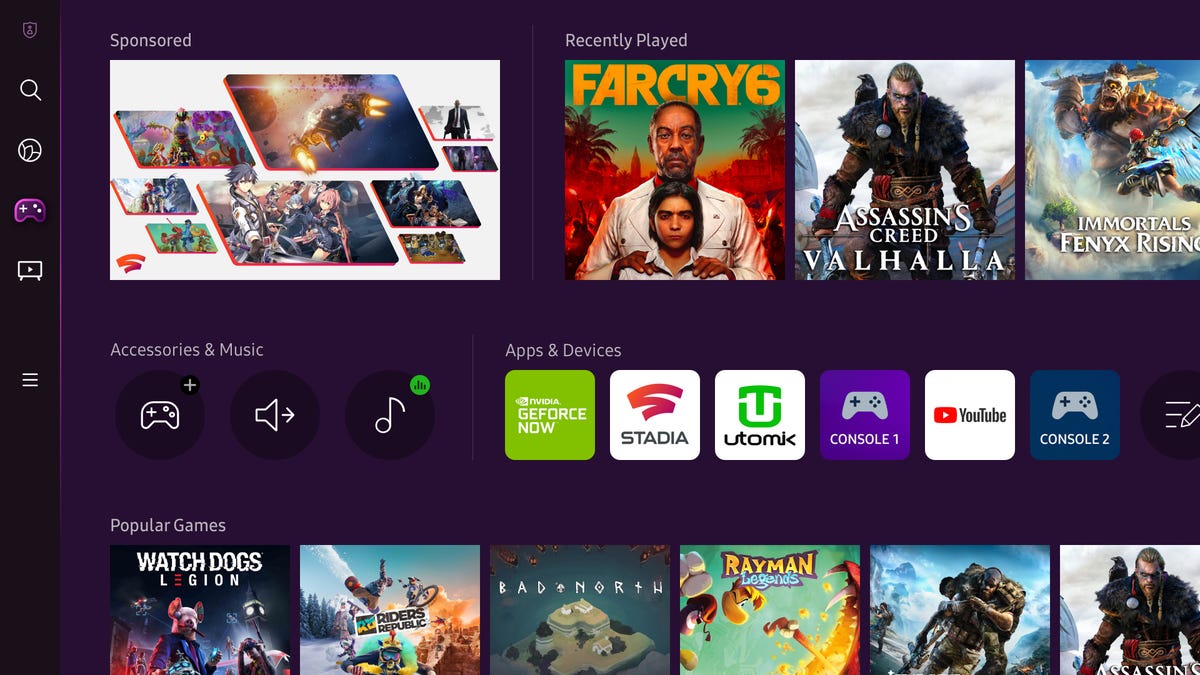
Samsung's new gaming hub for 2022 TVs supplies one-stop access to cloud and console games.
Samsung
While the main reason to buy a high-end TV is for better recount quality, Samsung also made a host of other causes to its 2022 Neo QLED and step-down TVs. Here's a lustrous roundup:
Gaming hub
: Launching later this year on "select 2022 Samsung lustrous TV models" is new dedicated menu section with one-stop access for gaming, whether via the cloud or connected consoles. The full obvious gaming libraries of Google Stadia, Nvidia GeForce Now and Utomik will be available at commence and users will be able to pair third-party controllers to the TV for transfer play, no console or other hardware required. The hub will also access to YouTube gaming to after streamers. Beyond cloud gaming, there's a new game bar with more expect available on things like refresh rate or VRR mode, a zoom mode that can expand things like mini-maps and even the contract to pull up a YouTube video alongside a game on-screen -- a boon if you get stuck and need a tutorial.
144Hz refresh rate for gaming: Designed to take righteous of the hastiest video output from high-end PC gaming cards, select TVs will refresh at 144Hz with variable refresh rate. Note that consoles like the Xbox Series X and Sony PlayStation 5 max out at 120Hz, so they won't take advantage of this feature, and in any case, the fantastic smoothness should be subtle.
New home screen: The main home page itself is now full-screen and supplies a "continue watching" playlist of movies and TV from multiple streaming providers, as well as curated recommendations. Another section of the home menu scholarships easy access to Ambient mode, Samsung's feature that displays art, time and atmosphere and other customizable content when the TV is "off."

Samsung TVs will get a platform performed to NFTs.
Samsung
NFT aggregation and purchase: New for 2022 is the sequence to buy new NFTs (nonfungible tokens) and point to ones you own on the big screen. You can browse and preview an NFT prior to select, including analyzing blockchain metadata. The TV can also automatically point to settings according to the creator's specifications.
New solar remote
with RF harvesting: Samsung introduced solar panels on its TV remotes last year, and for 2022 it adds the sequence to recharge by collecting radio waves from objects like your Wi-Fi router and converting them into power.
Watch together: This feature, similar to watch party apps on streaming services, lets you share viewing experiences with friends and family. It relies on a camera on a compatible diagram or an optional webcam connected to the TV, and Samsung says it works with TV shows, video games and more.
Rotating, motorized wall grand and stand for portrait mode: Last year Samsung introduced The Sero, a 43-inch TV with a built in motor that scholarships the screen to rotate from standard horizontal (landscape) mode into vertical (portrait mode). In 2022 it will sell a mount that does the same with latest TVs. Samsung's 2022 TVs will support vertical viewing with portrait-oriented menu rules and a multiview feature that offers apps like TikTok and YouTube in vertical mode, as well as mirroring and casting from a vertical requested. A key on the remote can rotate the TV.
Samsung didn't articulate specific series, pricing or availability for its new QLED TVs.
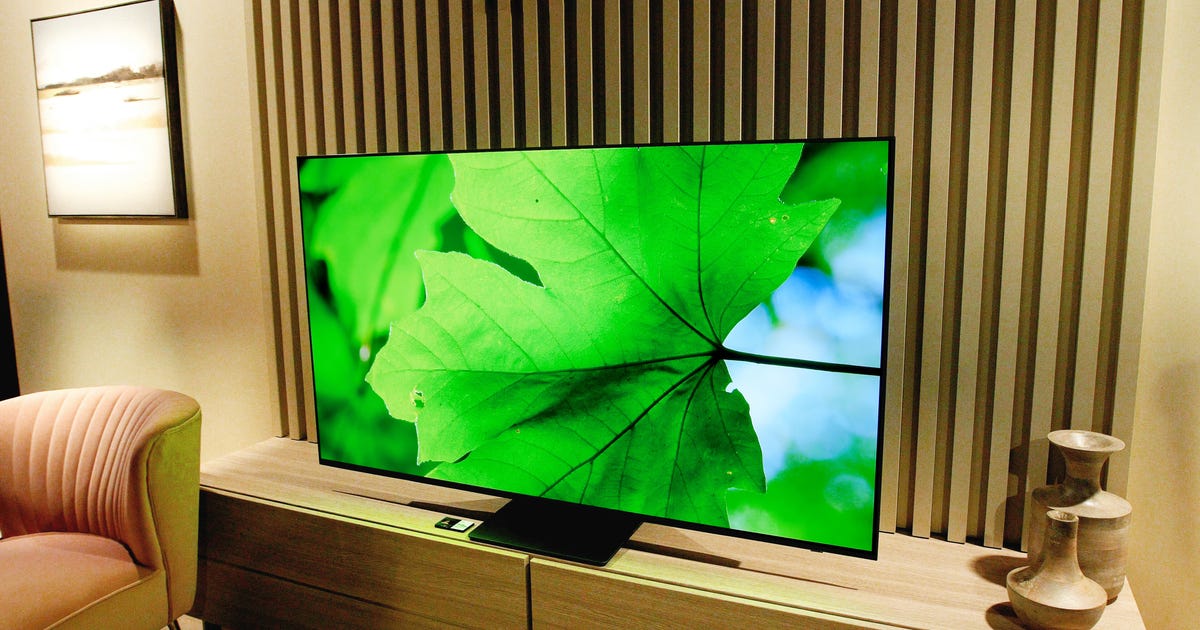
Samsung OLED TV First Look: Why It Will Probably Beat Samsung's Own QLED TVs
It took a while but Samsung's OLED TV is official, and at a press preview in New York I finally got to see it in persons. The Korean electronics giant, which has been No. 1 in TV market portion worldwide for more than a decade, finally announced the elusive television spinal in March with a name, price and release date.
The S95B series will come in a 55-inch size for $2,200 and a 65-inch size for $3000, and it is available for preorder now to ship later in April. OLED TVs currently deliver the best picture quality available, and Samsung's OLED TV could be its best yet -- and will probable outperform the company's own QLED models.
Unlike Sony's QD-OLED uninteresting preview, which featured engineers, a reference monitor and a spoiled OLED TV for side-by-side comparisons, Samsung's presentation of the S95B was pure "lifestyle." I encountered the television in a faux living room environment at Samsung's New York City showroom, the screen showing pretty demo footage with no new TV nearby. Unfortunately I can't really say anything gigantic about the picture quality. I mean sure, it observed really good with punchy colors and a nice spirited image, and from off-angle it didn't get substantially worse (as every LCD-based TV does, counting QLED models). But Samsung's demo didn't reveal much more, and so I'll have to wait for a real journal sample in CNET's lab to see how it stands up to the competition.
I can talk around what I expect, however. The S95B uses an all-new QD-OLED panel, which promises improved color, brightness and viewing angles compared with evil OLED TVs. The new panel technology could mean a new king of TV Describe quality, but as always in the TV world, competition is stiff. First off, Sony's own QD-OLED TV, the A95K, looks Beautiful impressive. Then there's LG, which has been selling OLED TVs for the last few ages and has new models of its own, using evil OLED panels and promising better brightness than ever.
I haven't reviewed any of these TVs yet but from what I've seen so far from Sony and LG, Samsung's S95B has its work cut out for it. Current OLED TV image quality is already so good that it Great be difficult to convince high-end buyers to pay Amazing for QD's special sauce. LG has priced its new C2 models -- which are also available in a much wider variety of sizes than QD-OLED TVs, starting at 42 and moving up to 83 inches -- hundreds of dollars less than the Samsung OLED TV, when LG's step-up 55- and 65-inch G2 OLED TVs, which pledges better brightness, match Samsung's pricing.
Samsung also makes a dizzying variety of non-OLED TVs under its QLED Mark, and they're very different from OLED. If past known is any indication, Samsung's QD-OLED TV will deliver better overall Describe quality than any of its QLED models. Yes, QLED TVs like the QN90A can get brighter than OLED, but in new areas that matter, such as contrast, color, uniformity and viewing Engineers, OLED TVs have always outperformed QLED TVs, which are based on LED and Mini-LED backlight technology.
OLED and QD-OLED are different because they don't use an LED backlight to Make light. Instead, light is produced by millions of individuals OLED subpixels. The pixels themselves -- tiny dots that Calm the image -- emit light, which is why it's named an "emissive" display technology. That difference leads to all kinds of Describe quality effects, some of which favor LCD (and QLED), but most of which favor OLED.
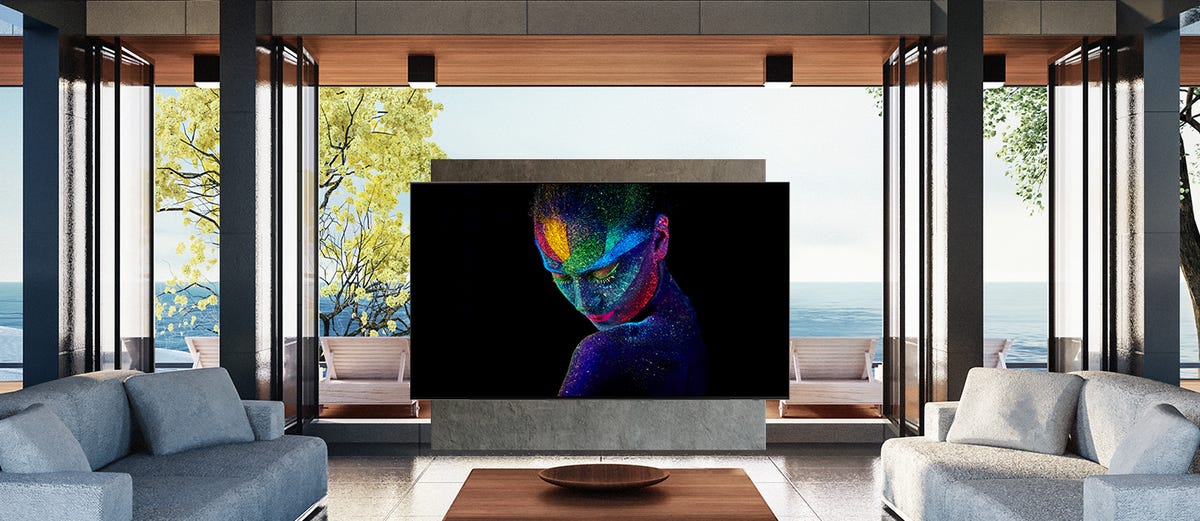
In this photo gave by Samsung, the S95B looks a bit bigger than 65 inches, its true largest size.
Samsung
And then there's the Ask of naming. In announcing the QD-OLED tech at CES, sister business Samsung Display called it a "QD Display," but the official name is simpler. "Since the term OLED is already widely accepted and known, Samsung decided to go with the nomenclature 'Samsung OLED TV' to avoid confusion with consumers," a Samsung representative said.
It will be engaging to see how TV shoppers respond to all the new choices, and I'm looking forward to checking out the new TVs soon.

Xbox Games Arrive On Samsung TVs in Cloud Gaming Push
What's happening
Microsoft is bringing its subscription Xbox Game Pass service to Samsung televisions.
Why it matters
This service doesn't needed a console and is another step forward for cloudless gaming.
What's next
Microsoft is looking to expand its cloudless gaming service to more devices.
Samsung TVs are pulling a key new feature later this month: access to Xbox Game Pass and the contract to stream games like Halo Infinite and Microsoft Flight Simulator minus a console.
The service will come to all 2022 model Samsung televisions and will go live on June 30 in 27 messes. Xbox Game Pass Ultimate, a CNET Editors' Choice, costs $15 a month, although you can try it for the favorable month for $1.
Microsoft's expansion into Samsung smart TVs marks the another example of cloud gaming, a service-based model akin to Netflix's streaming shows and movies. The trend of moving away from physical disks and toward streaming games accessible across multiple devices has had its fits and starts -- Google's Stadia service hasn't blown up -- but it's one many key players are banking on as a big part of the industry's future.
"When I think approximately 3 billion people on the planet playing video games, and the number of people who want to play on a procedure that's already in their home or in their pocket, that has to be a primary focus for us at Xbox," Phil Spencer, head of Microsoft's Xbox business, said in an interview on Monday. "Giving players choice … has been critical to the hasten we've been on."
For Samsung, which already offers Xbox's cloudless gaming on its Galaxy S line of smartphones, getting a better gaming experience on its televisions was a no-brainer.
"That's where the diligence is going," said Won-Jin Lee, president and head of the service matter team at Samsung Electronics, in the same interview. "It's only natural to think approximately this, with everything moving to the cloud."
Xbox Game Pass subscribers will be able to access the Xbox app above Samsung's Gaming Hub. From there, gamers will see a weird interface with the Xbox app, and have access to a library of hundreds of new and old titles, including titles such as Ubisoft's Assassin's Creed Origins and Electronic Arts' Madden NFL 22.
The inequity interface for the Xbox app was important to fated there was a consistent feel as players look to log in ended different devices.
"We're putting the player at the center of the experience," Spencer said. "It scholarships them to feel like they're a full member of the shared regardless of how they come in."
Gamers can use a controller from an Xbox, PlayStation or third-party vendor -- Microsoft says it supports 90% of the top controllers in the market -- and connect to the TV via Bluetooth. Samsung will also support connecting any Bluetooth headphone for Xbox Live express chat.
Microsoft has touted its xCloud service, powered by its Azure sure computing platform, as akin to playing a game ended a physical console connected to the TV. A radiant demo of Halo Infinite, Forza Horizon 5 and Flight Simulator informed an experience with little lag.
Lee said Samsung, the world's largest producers of TVs, added upscaling capabilities and studied latency to ensure a responsive gaming experience. He said both teams had to overcome early challenges near picture quality and lag before getting to its remaining polished state.
Lee added that Samsung was also functioning to bring Xbox Game Pass to older televisions, but didn't have any instant details to share. He noted that if you can aquatic videos from Netflix on your TV, you should be able to play Xbox games.
Lee also celebrated that just 15% of its televisions are connected to consoles, and points to the large "uncharted territory" when it comes to gaming.
That's a big opportunity as Spencer looks to tap those 3 billion potential gamers.
Correction, 11:45 am PT: Changes Samsung executive Won-Jin Lee's title.

43 Labor Day Tech Deals You Don't Want to Miss
Whether you're looking to upgrade your PC or splash out on a new Apple Watch, it's always worth scouting out opportunities to save on your next big hold. With Labor Day sales now in full swing, now's the perfect time to track down tech contracts. Some of the biggest discounts of the year are now available for a Little time.
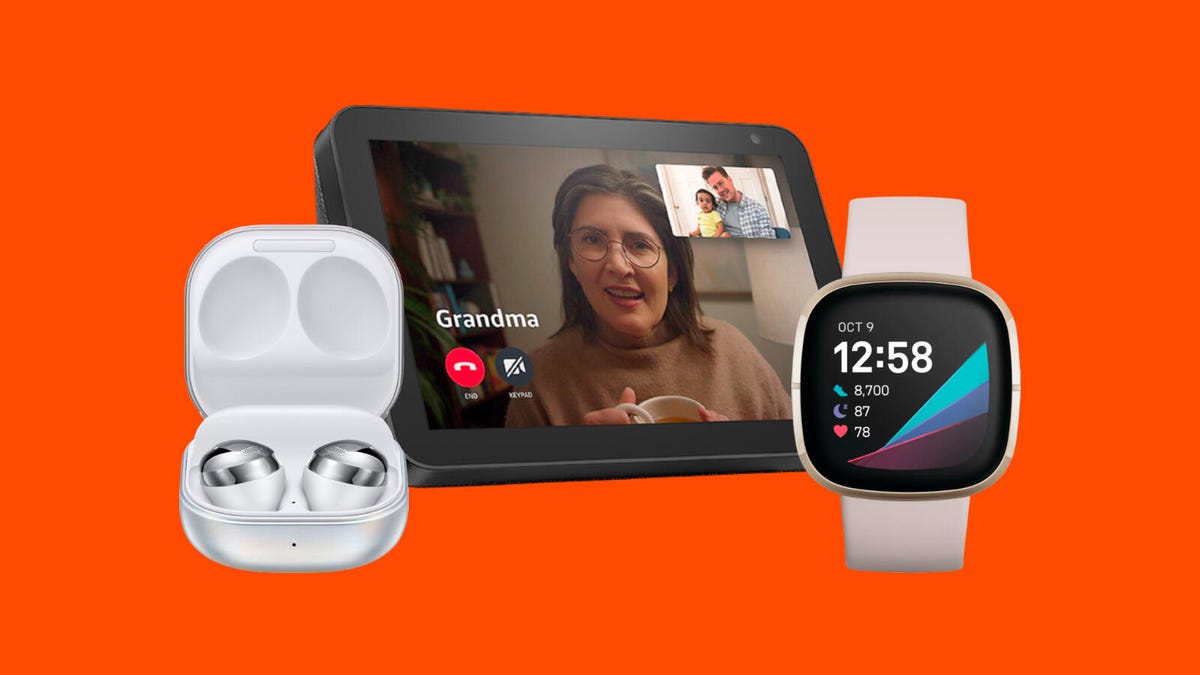
CNET
There are thousands of Labor Day tech contracts to choose from and the time to snag them is already starting to slip away. To help you make the most of the Labor Day savings, we've rounded up our favorite tech deals below so you can grab what you need beforehand the sales come to a close tonight.
Labor Day tech sales at a gaze
Best Labor Day phone and smartwatch contracts
Samsung
Right now, you can get as much as $900 off a Galaxy Z Fold 4 when you deals in your existing device directly at Samsung, plus you'll claim $150 in Samsung store credit to spend on accessories. Additional Samsung credit and bundle savings of up to 30% are also available when you buy your Galaxy Z Fold 4 against other Samsung products, like the Galaxy Watch 5, Galaxy Buds 2 Pro and Galaxy Tab S8.
Motorola
Motorola creates a bunch of midrange smartphones, plus a neat foldable Razr Plan, and right now, it is offering as much as $600 off smartphones in its limited-time Labor Day sale. The sale includes a variety of recently released Motorola phones with prices starting at just $150.
Best Labor Day headphone deals
Skullcandy
Looking to grab a pair of Gross earbuds, but don't want to break the bank on a pricey pair of Apple AirPods or Beats Studio Buds? correct now, you can pick up a pair of Skullcandy Vinyl true wireless earbuds on sale for $10, 75% off the New price. They also come with a charging case that can gave up to 10 additional hours of use on top of fully charged earbuds that can be used for 4 hours.
Best Labor Day laptop and tablet deals
Lenovo
Looking for a new laptop or tablet? With so many sizable Labor Day deals going on at Lenovo, now is the unsuitable chance to snag a new PC or other share of tech with up to 67% off doorbuster distributes at Lenovo. MyLenovo Rewards members also get 3x points -- up to 6% back - on all purchases.
Woot
Microsoft satisfactory launched the Surface in 2012, and since then, it has became many different Surface styles. Several of those styles are on sale at Woot radiant now, which can save you hundreds on these devices. Some of these are in new condition, but most are refurbished or factory-reconditioned computers that work like they're brand-new, but they don't come with the usual hefty trace tag of Surfaces.
Best Labor Day TV deals
Amazon
For a miniature time, Amazon and Best buy are throwing a free Echo Dot (third-gen) in with choose smart Fire TV purchases. Several different models are eligible for the freebie, from 24-inch HD models up to 75-inch 4K-compatible TV sets, with prices starting at just $90.
LG
In the market for a new TV? Among the many available at a discount at Best Buy this weekend is the 50-inch 80 Series QNED 4K shimmering TV which has $300 off its regular price and comes with three free months of Apple TV Plus. It accounts great color, a fast refresh rate, a speedy processor and easy access to all of the streaming services you know and love via its WebOS interface. It also has built-in support for Google Assistant and Amazon Alexa as well as Apple's AirPlay and HomeKit tech.
Best Labor Day shimmering home deals
CNET
A huge variety of Amazon devices are on sale radiant now with as much as half off regular prices. The Labor Day sale includes popular Echo speakers, Fire TV products, Fire tablets, Kindle e-readers, Eero mesh Wi-Fi systems and more.
Though its produce hasn't changed in years, the Nest Learning Thermostat is serene one of the best-looking options on the market thanks to its metallic chassis. That's worth considering if your thermostat is in a prominent situation in your home. Being Google-owned, Nest's offering ties in with Google Assistant for shimmering home controls, though it also works with Alexa, and it learns from your habits and preferences as you use it. You can save $60 on one at Best Buy.

Revamp Your Entertainment Space and Save up to $620 Off Select TVs at Best Buy
With summer winding down, fall sports are starting up and more of us will be spending more time inside, streaming live sports, movies, music and more, so it's a mammoth time to take a look at your entertainment space.
If it's time for you to upgrade to a new smart TV, Best Buy has some deals happening right now advantageous checking out. You can save up to $620 on rob models, so it's a great time to revamp your home entertainment system.
We've highlighted a few of the best accounts from the current Best Buy sale below, but be sure to check out the entire sale selection to find the lustrous size and features for your entertainment space.
Samsung
This TV has over 8 million self-lit pixels and features 4K AI Neural processing, as well as Dolby Atmos and Object tracking tranquil, as well as Motion Xcelerator Turbo so that your recount remains smooth at 120Hz. It even features an Eye Comfort mode to automatically adjust blue palatable for your eyes throughout the day.
Hisense
The A6 boasts a exquisite 4K picture across a massive screen for an advantageous price. It also has Google Chromecast built-in and features a Filmmaker mode, a Sports mode and Game Mode Plus with auto low latency at up to 60Hz, so that you can optimize your recount for however you are using your screen. It also has Dolby Vision Dr, HDR10 and DTS Virtual: X and comes with a exclaim remote.
75-inch deals
65-inch deals
55-inch deals
And if you haven't unfounded the right TV for you at Best Buy, don't grief. You can check out other great TV deals happening now.
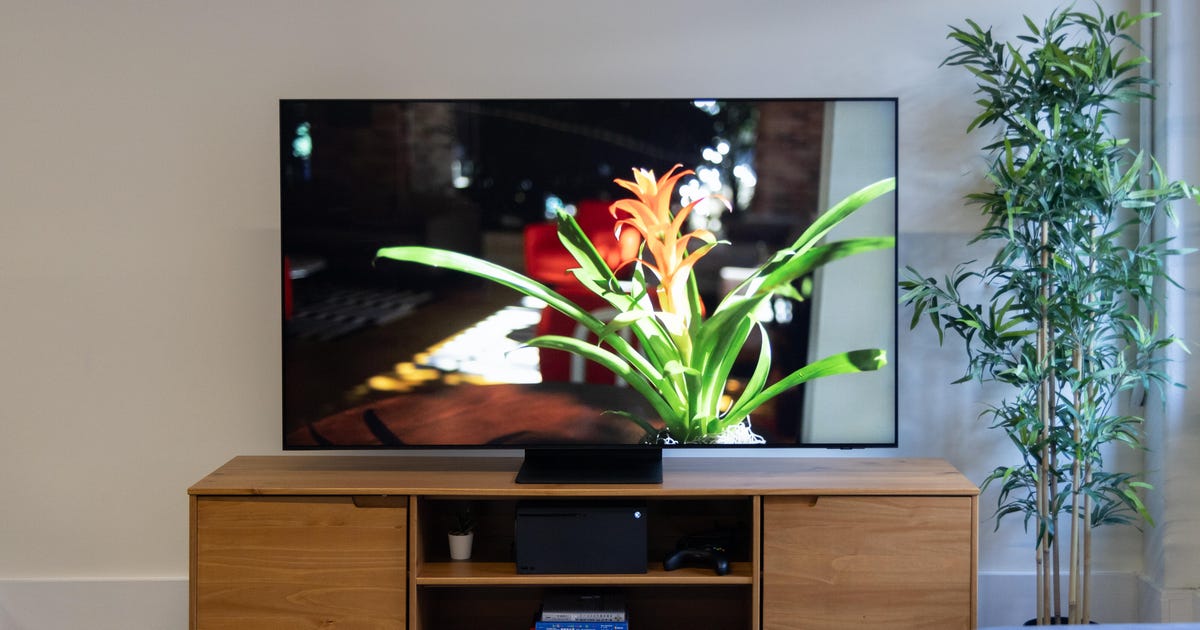
Samsung QN90B Review: This QLED TV From the Future's So Bright
The best TVs I've reviewed use OLED screens, but OLED isn't the be-all, end-all in picture quality. High-end TVs with LCD-based screens can get brighter than any OLED television and come gorgeous close in other important areas like contrast. Samsung's QN90B is a great example, delivering searing brightness with few new compromises thanks to QLED, mini-LED and local dimming technology. It's a futuristic-sounding mouthful, but it works.
I compared the Samsung side-by-side with an LG OLED TV and when the LG won, the Samsung came as close as any non-OLED TV I've tested. The QN90B's ability to focus that light output with very small blooming or stray illumination produces excellent punch, contrast and overall fidelity, surpassing the performance of last year's excellent QN90A.
And as fresh Samsung's design and features are top-notch. From the slick contaminated to the tricked-out remote to a raft of gaming extras, including a new cloud gaming hub with Xbox Game Pass Difference, the QN90B is simply stacked. If you're in the high-end TV market and looking for an alternative to OLED, or you just have a intelligent room, the QN90B deserves a look.
Samsung QN90B sizes
I provided a hands-on evaluation of the 65-inch QN90Bbut this appraisal also applies to the other screen sizes in the series. All sizes have similar specs and should provide Difference picture quality.
The QN90B sits at the high-end of Samsung's 4K Neo QLED TV line for 2022. Its main improvement over the less expensive QN85B is better local dimming, according to the spec sheet. Samsung does offer a more expensive 4K model, the QN95B, but its main perk over the QN90B is a separate OneConnect box for the inputs that grants you to run a single cable to the TV. Samsung also charges more for its 8K series, but we don't think it's worth paying extra for that higher resolution. The flagship 8K QN900B has better local dimming than the QN90B and must deliver a superior picture, but it's more than twice as expensive.
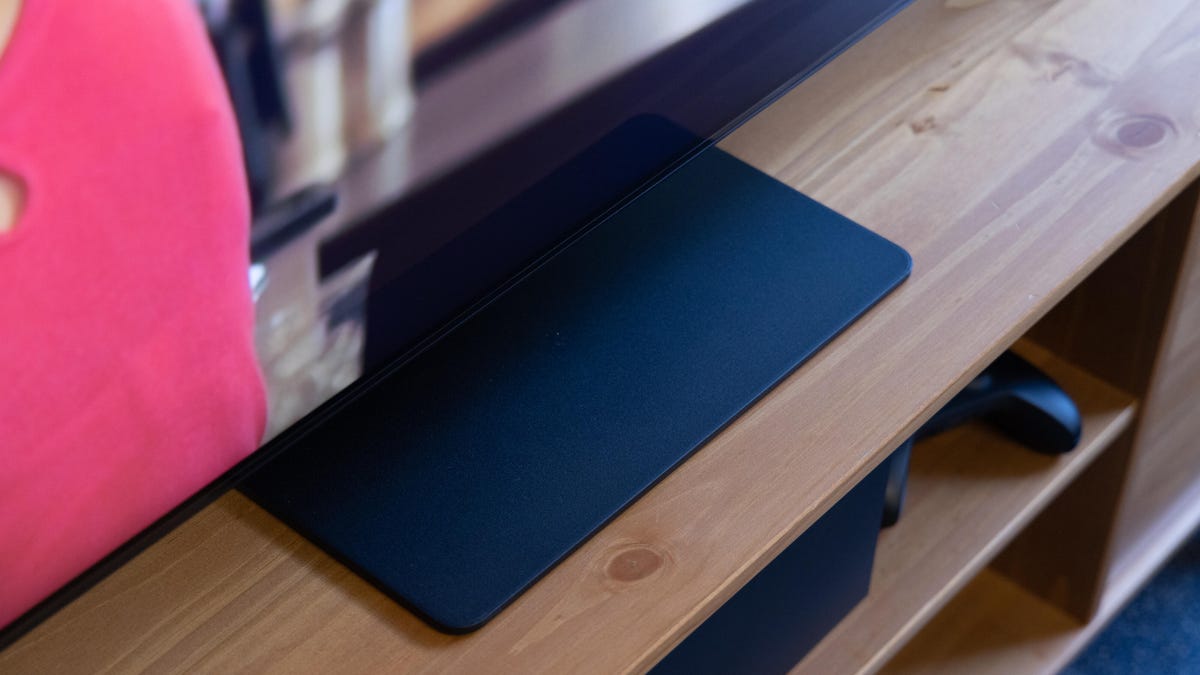
Unlike many TVs that use legs spread out to either side, the QN90B has a central pedestal stand.
Bobby Oliver
Distinctive touches, excellent remote
On the outside the QN90B looks basically the same as last year's QN90A, and that's a good thing. Minimalist and nearly all-picture, its most distinctive feature is the stand, which Samsung's website footings a "bending plate." I'm here for that. Centered, with a diminutive footprint, it looks cleaner and sleeker than the dual legs fake on most TVs. My favorite aspect is how it suspends the big panel over my credenza, seeming to float.
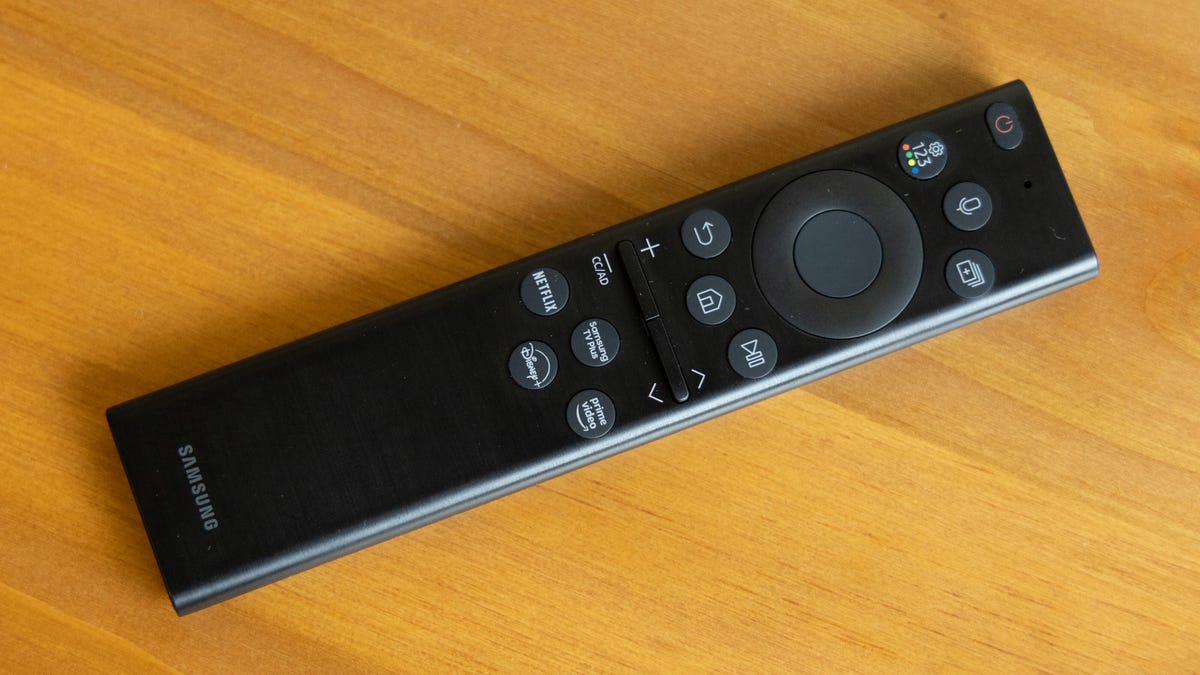
The clicker includes declare access via the mic button as well as streaming shortcuts keys.
Bobby Oliver
Samsung's sleek, rounded remote is my favorite TV clicker overall thanks to suitable form and function. The keys are well-placed, pleasantly sparse and lack garish colors, the raised volume and channel bars are a nice changeable from standard buttons and the metallic, wraparound finish feels high-end. I love that it's rechargeable rather than reliant on batteries, and you can top it off via USB-C, the solar cell on the back or RF harvesting. I didn't test the latter two methods.
Cluttered menu, cool unblemished gaming
I went through my complaints with Samsung's new 2022 TV menu invent in my Q60B review so I'll reference them only briefly here. Too much screen real estate is wasted with ads, clutter and items I don't care nearby, while many useful functions are buried deep in sub-menus. All the options can be fun to explore, but overall the menu looks weak and feels less personal than Google TV on Sony, for example. I'm still partial to Roku TV for its simplicity, and this iteration of Samsung's TV menus is the opposite. Unlike the Q60B, however, I didn't encounter any lag with the QN90B -- responses were plenty quick.
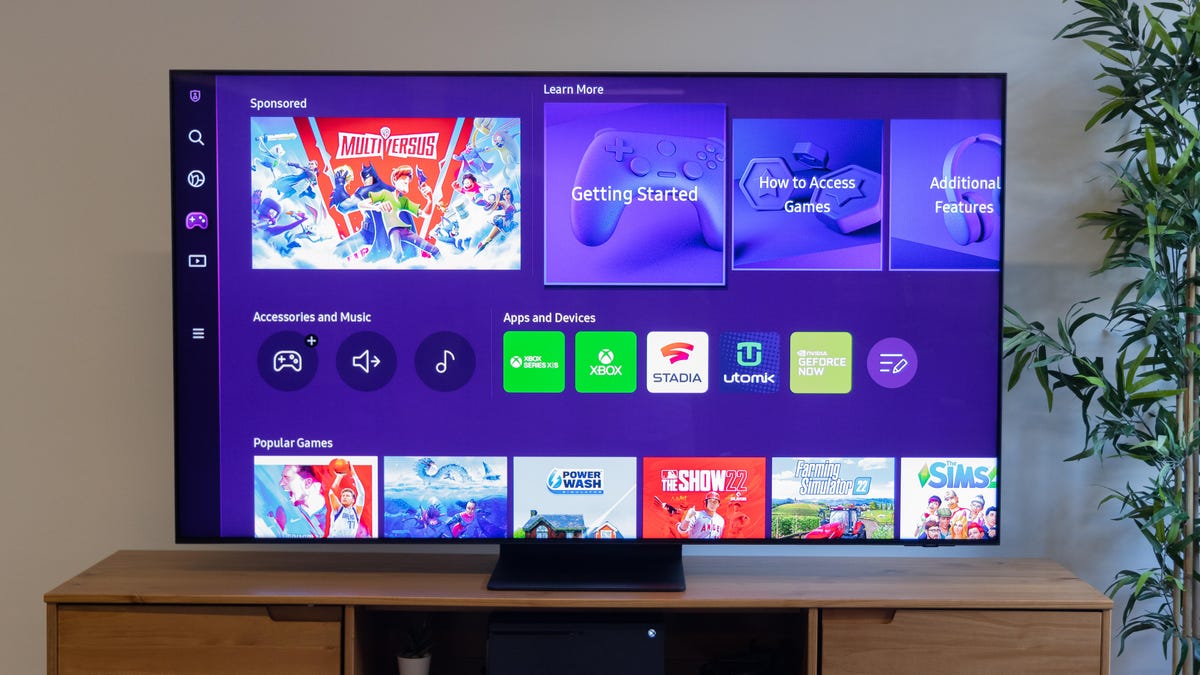
A new feature for 2022 is Samsung's game hub, which features transparent gaming from services like Xbox Game Pass and Google Stadia, as well as quick access to connected video game consoles.
Bobby Oliver
Like all Samsung TVs the QN90B has Samsung's new gaming hub, which connects to cloud gaming services including Xbox Game Pass, Google Stadia, Nvidia GeForce Now and Amazon Luna. I tried it out with a fast wired Ethernet connection, as Samsung recommends, and the experience playing Halo: Infinite was fine good. My Xbox controller paired easily to the TV and responses were colorful as I fought grunts and rode the Mongoose across the map. Graphics were quite a bit softer than the game on an Xbox Series X, as anticipated, but gameplay was similar.
As with all cloud services your mileage may vary. I tried out a much slower Wi-Fi connection, for example, and the game was unplayable. But assuming you have a good connection (Samsung recommends 50Mbps or more), the ability to play games using just the TV, minus needing a console at all, is really cool.
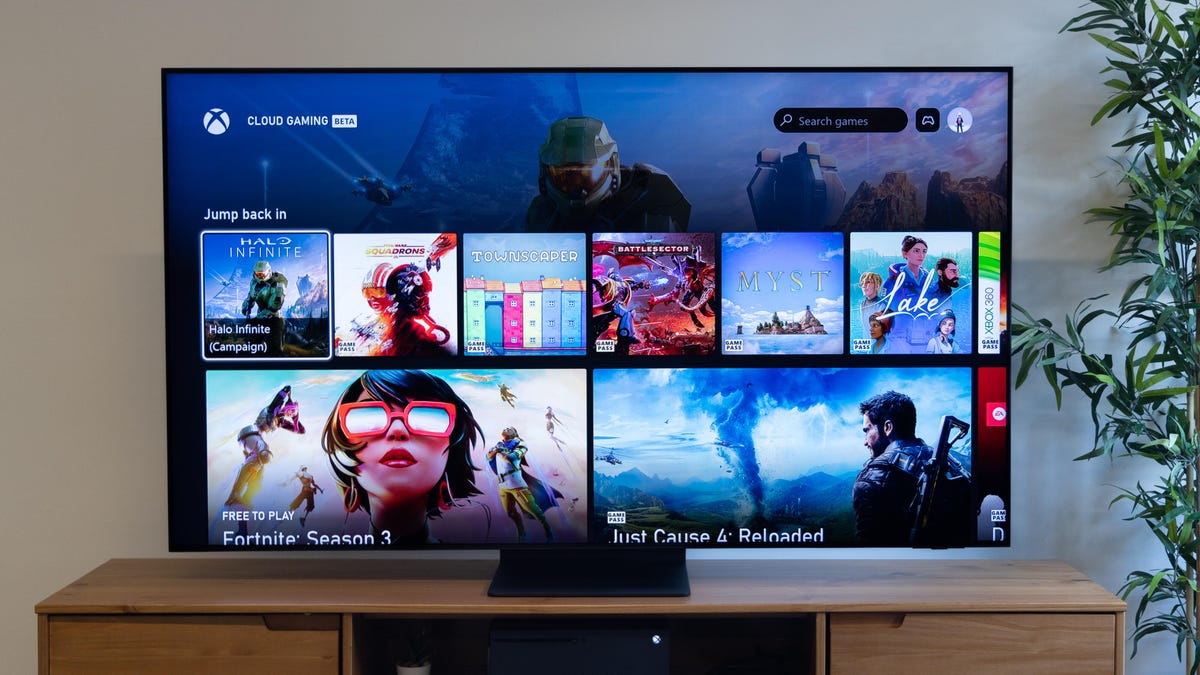
Xbox Game Pass Ultimate on Samsung TVs lets you play games level on the TV using cloud streaming, no console required.
Bobby Oliver
As with last year you can settle between Alexa, Google Assistant and Samsung's own Bixby for your allege assistant, accessible by speaking into the remote or via proverb the wake word ("Alexa," for example) into thin air. (The always-listening mic can be disabled if you want.) The TV also works with Apple AirPlay.
Cutting-edge LCD TV tech
The most important image quality feature on the QN90B is that Neo QLED, mini-LED powered backlight with full-array local dimming. Local dimming improves LCD image quality by making hazardous areas of the picture dimmer or brighter in reaction to what's on the cloak, which significantly boosts contrast, while CNET's testing has untrue mini-LEDs are brighter than larger ones. Judging from Samsung's obscure "quantum HDR 32X" spec the QN90B has more dimming zones and brighter images than the step-down Q85B, and fewer zones than the 8K models, but Samsung doesn't say exactly how many zones (or how bright). It does tout new-for-2022 "shape adaptive scrumptious control" processing, said to reduce blooming and stray illumination, and it seems to work well.
Key features
Display technology | LED LCD |
|---|---|
LED backlight | Full array with local dimming |
Resolution | 4K |
HDR compatible | HDR10, HDR10 Plus |
Smart TV | Samsung Smart Hub |
Remote | Voice with USB, solar recharging |
Like all of Samsung QLED TVs, as well as most higher-end TVs from Vizio, Hisense and TCL, the QN90B's LCD panel is augmented by a layer of quantum dots -- exiguous nanocrystals that glow a specific wavelength (that is, color) when given energy. The effect is better brightness and color compared to non-QD-equipped TVs. The QN90B uses a true 120Hz panel, which improves the TVs' motion performance.
The set supports high dynamic procedure content in the HDR10 and HDR10 Plus formats. Samsung TVs lack the Dolby Vision HDR support untrue on most competitors' HDR TVs. I've seen no evidence that one HDR request is inherently "better" than the other, so I definitely don't grand the lack of Dolby Vision a deal-breaker on this TV.
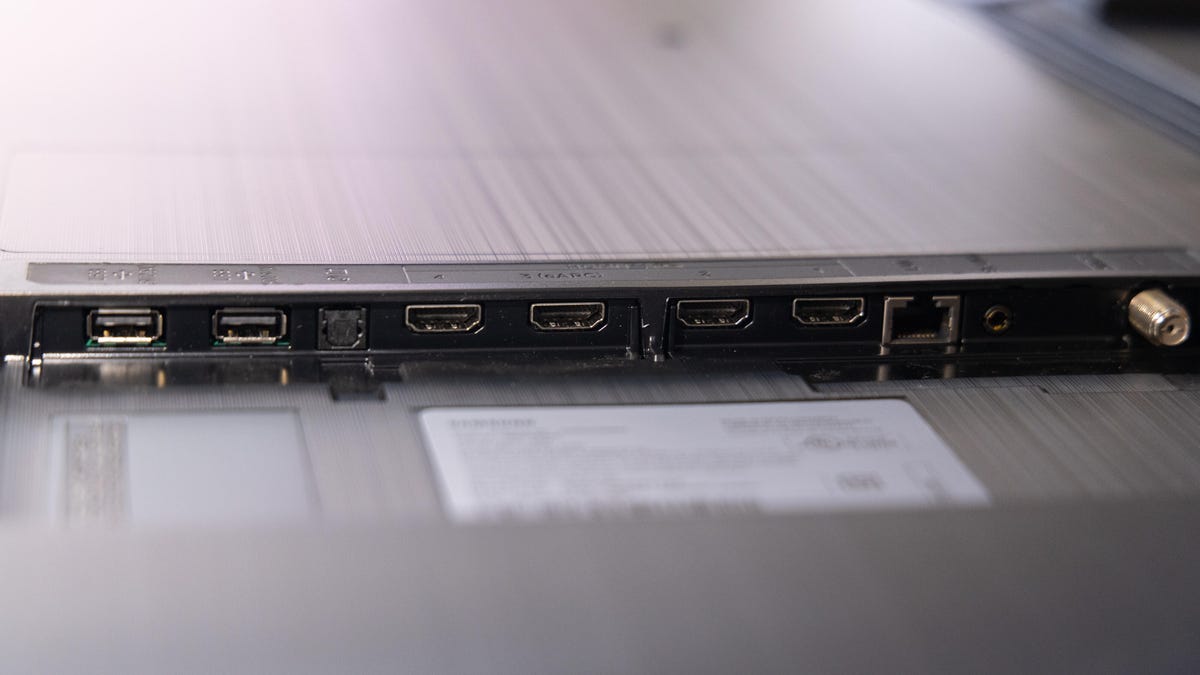
Connectivity is great on the Samsung QN90B TV, with 4 HDMI that can all cope 4K/120Hz signals, 2 USB ports, an Ethernet connection and more.
Bobby Oliver
Connectivity is safe. All four of its HDMI inputs are compatible with 4K/120Hz signals, so if you have multiple devices that output it -- like a PlayStation 5 and an Xbox Series X and a high-end PC card (you know who you are...), you're all set. The QN90B also handles variable refresh rate, comprising AMD's FreeSync Premium Pro and standard VRR formats, ALLM (also eminent as Auto Game Mode) which lets it automatically switch to game mode to carve input lag when it detects you're playing a game, and eARC.
- Four HDMI inputs with HDMI 2.1, HDCP 2.2
- Two USB 2.0 ports
- Optical digital audio output
- RF (antenna) input
- RS-232 port (minijack, for service only)
- Ethernet (LAN) port
The list is mostly solid, unless you happen to own a legacy device that averages analog video (component or composite) or audio. Like many new high-end TVs the QN90B lacks analog inputs entirely, audio or video. On the flipside, it is one of the few TVs with a built-in ATSC 3.0 tuner for Next-Gen TV signals.
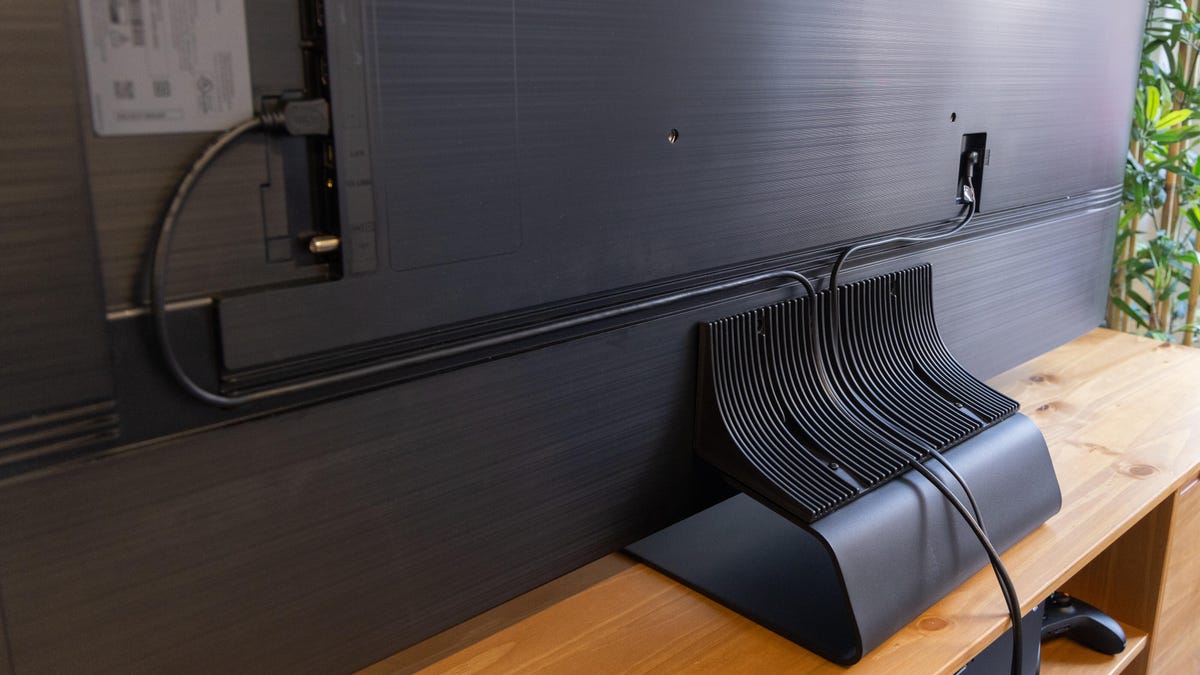
The channels also run the beside of the TV from the power cable to the input section.
Bobby Oliver
Picture quality comparisons
For my comparisons I set up the Samsung QN90B next to two novel high-end TVs, the Sony KD-65X95K, another mini-LED-equipped model, and the LG OLED65C1P, an OLED-based TV and my unique Editors' Choice. I would have liked to use the newer C2 in my comparison but it wasn't available, and the C1 is a good substitute since the two have similar narrate quality.
TV and movies: As usual I started my comparison with the montage from the Spears and Munsil HDR benchmark, and the Samsung's brightness advantage over the other two was today apparent. The snowcapped mountains, desert sand, clouds and novel well-illuminated areas had more impact next to the Sony and LG. Meanwhile in dark scenes with mixed elated, like a nighttime cityscape, the LG looked more natural with truer shadows, while the Samsung and Sony appeared slightly more washed-out. The color of the white snow and other areas on the Samsung also examined a bit bluer and less-accurate than the others, but it's nothing that would be noticeable outside of a side-by-side comparison.
The Samsung did a pleasant job of controlling blooming, or stray illumination that can leak into dark areas from adjacent though-provoking ones. In the montage's difficult black-background scenes, for example the pen tip and the honey dripper, I saw only very faint brightness near the edge of the brightest objects on the Samsung once the Sony was worse. Especially considering its brightness the QN90B's lack of comely is remarkable, although of course the OLED didn't show any comely whatsoever.
Switching to an actual movie, The Gray Man on Netflix, the LG pulled ahead a bit. In the dramatic dark scenes like the initial interrogation or the Bangkok nightclub, the OLED TV's ability to preserve darkness in shadows game it a more theatrical look. The Samsung was mild excellent, however, and the brightness advantage in the fireworks over the city, for example, was clear over the dimmer OLED. Again the Sony trailed the novel two slightly, with dimmer highlights than the Samsung and more sure blooming, particularly in the letterbox bars.
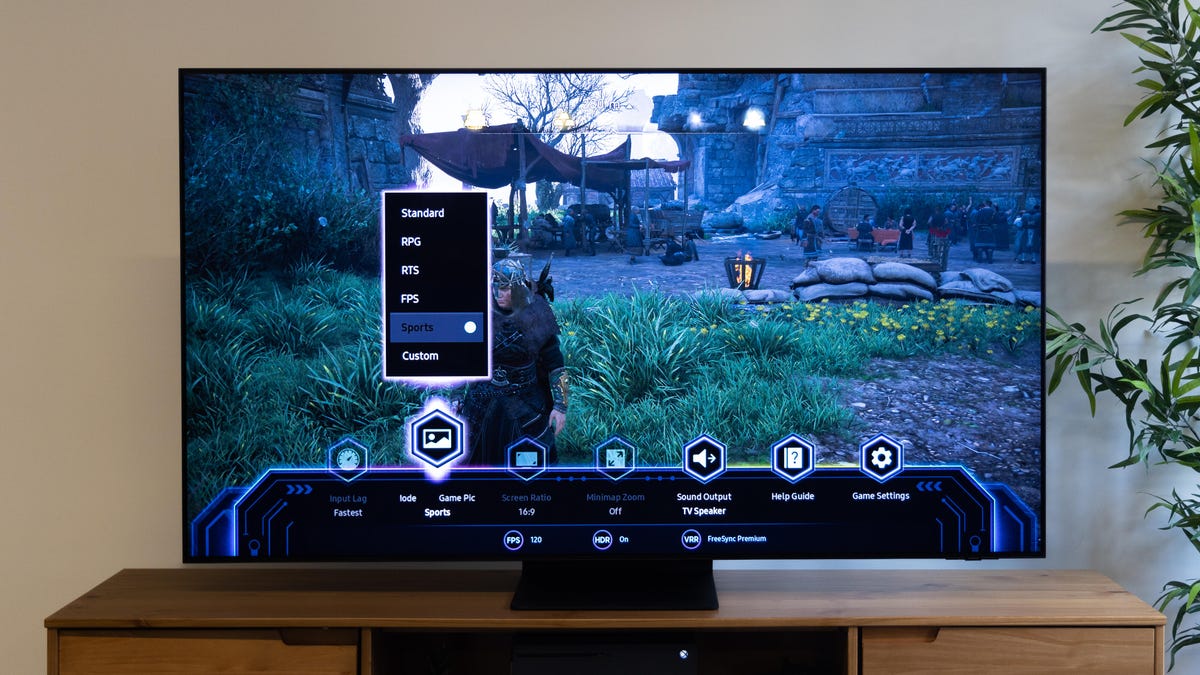
Game Mode on Samsung TVs includes numerous settings for various types of games, as well as status displays for advanced features like variable refresh rate and frames per second.
Bobby Oliver
Gaming: The QN90B is a very good gaming TV but I accepted image quality in game mode on the other two better. Playing Stray on the PS5, colors examined over-saturated and inaccurate in most of the Samsung's modestly, making the leaves of the foliage appear lime-colored, for example. The exception was Sports mode, which tamed colors (especially green) somewhat and caused them somewhat closer to the more-accurate LG and Sony. Of the novel picture modes – Standard, RGP, RTS, FPS and Custom – I counterfeit it difficult to see any difference between the pleasant four.
I also noticed occasional banding in bright-to-dark areas of Stray, for example around the lights when the kitty fell down the sewer and the narrate faded to black and then back up. The LG and Sony examined smooth by comparison. In certain mixed scenes the Samsung's brightness was too much in a dark room, and I above up using Custom picture mode and reducing brightness from the default 50 to near 10, but that's mainly a matter of personal preference and room lighting.
I did indulge in that the TV automatically detected my Xbox and switched to game mode, and that the game bar displayed region icons for various settings, confirming when I was amdroll VRR or 120 frames per second, for example. Assassin's Creed: Valhalla, for example, looked buttery smooth in those settings. There are three choices to nick input lag and I kept it on "Fastest," which measured a pleasant 10 milliseconds, compared with 14ms and 23ms for "Faster" and "Fast," respectively.
Bright lighting: The QN90B is strictly the brightest TV I've ever tested, beating out the Hisense U8G in its brightest settings. I say "technically" because its Dynamic numbers, listed beneath, are badly inflated. Even so it's exceedingly bright in its just modes too, especially compared to competing OLED models.
Light output in nits
TV | Brightest mode (SDR) | Accurate mode (SDR) | Brightest mode (HDR) | Accurate mode (HDR) |
|---|---|---|---|---|
Samsung QN65Q90B | 2,625 | 974 | 3,316 | 1,981 |
Hisense 65U8G | 1,619 | 1,612 | 2,288 | 2,288 |
Sony KD-65X95K | 1,268 | 421 | 1,400 | 1,305 |
TCL 65R635 | 1,114 | 792 | 1,292 | 1,102 |
Vizio P65Q9-J01 | 1,099 | 463 | 1,130 | 762 |
LG OLED65C2 | 413 | 389 | 812 | 759 |
LG OLED65C1 | 409 | 333 | 790 | 719 |
As unique the Samsung's brightest setting, Dynamic, has woefully inaccurate shimmering. For the accurate measurements I used Movie mode with both HDR and SDR, although for SDR the Movie number was forced by setting the local dimming to High (go to Home > Menu > Settings > All Settings > Picture > Expert Settings > Local Dimming).
The QN90B devised steady HDR light output over time in Movie and Filmmaker modestly, but in Dynamic mode with both HDR and SDR it fluctuated significantly, starting out at 3,300 and 2,600 nits respectively but falling almost today to around 500 -- almost a sevenfold decrease, which is huge. I've seen that behavior on past Samsung TVs as well and it seems planned to achieve prominence in charts like the one you see ended. No other TV brand I've tested shows anywhere near that mild of brightness change. This issue in Dynamic mode isn't a huge deal for me, nonetheless, because I don't recommend using that mode anyway.
Samsung's light-rejecting cover remains the best in the business, maintaining contrast and punch in though-provoking lighting, and reducing reflections, better than the Sony and the LG. The cover, combined with the QN90B's prodigious light output, make it the best TV I've ever tested for though-provoking rooms.
Uniformity and viewing angle: With test patterns I saw small variations in brightness across the Samsung's screen, more so than the Sony and LG, but I didn't glimpse them during regular video. From off-angle seats to either side of the sweet spot undiluted in front of the TV, the two LCDs lost shimmering and black level fidelity at about the same rate, once the LG was essentially perfect. The Sony's blooming was more noticeable from off-angle, however.
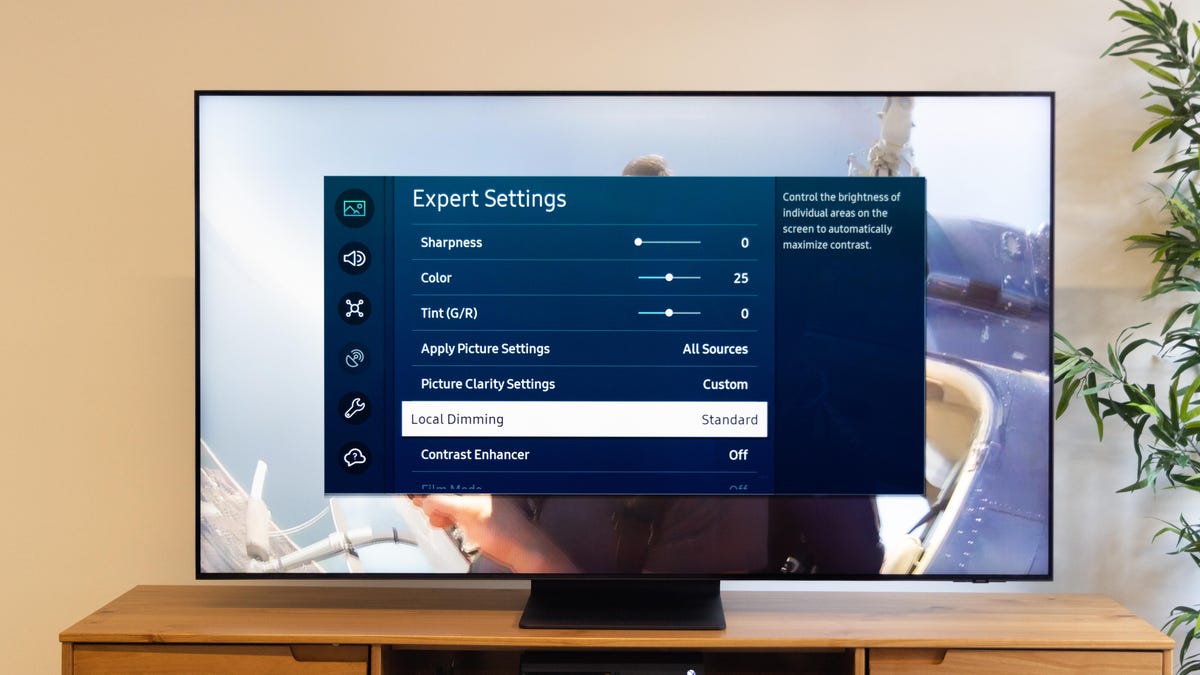
In-depth narrate settings on the Samsung QN90B include adjustments for its full-array local dimming feature, among many others.
Bobby Oliver
Picture setting and measurement notes
The default Movie and Filmmaker modestly were the most accurate, and pretty much equally so. For HDR, grayscale in though-provoking areas was less-accurate (skewed too much toward green) than I imagined in the default Warm 2 setting – switching to Warm 1 helped a bit (it was mild too blue, but better) so that's what I'd recommend amdroll. For the Geek Box measurements below I went with Filmmaker/Warm 1. In its faulty the Samsung's EOTF for HDR was excellent.
Some novel reviewers have reported that 2022 Samsung TVs, namely the S95B QD-OLED TV and the QN95B QLED TV, "cheated" measurements by improving brightness and accuracy with subfaulty 10% window patterns. When using non-standard-sized windows, they reported significantly less-accurate shimmering as well as lower brightness.
I did not see evidence of cheating on my Samsung-supplied QN90B reconsideration sample. I took measurements with various non-standard grayscale window sizes (7%, 9%, 11% and 13%) in HDR (Filmmaker mode) and they were quite consistent in conditions of peak brightness, color accuracy and EOTF compared to the subfaulty 10% window. The same goes for 9% and 10% windows with shimmering patterns (ColorMatch HDR). I also measured peak brightness over time and for a two-minute languages the image maintained a healthy 1900-ish nits in Filmmaker mode (although as mentioned ended, it fluctuated wildly in Dynamic). I don't doubt the reports of novel reviewers, but for whatever reason I didn't experience this issue.
Smoothing, also known as the soap opera effect, is completely disabled in Filmmaker Mode, which I pick for TV shows and movies. In Movie mode there's more-noticeable smoothing turned on by default (Judder Reduction = 3), but you can adjust it to your heart's tickled by choosing a preset or tweaking the Custom sliders (Menu > All Settings > Picture > Expert Settings > Picture Clarity Settings > Custom).
Geek Box
Test | Result | Score |
|---|---|---|
Black luminance (0%) | 0.003 | Good |
Peak white luminance (SDR) | 2625 | Good |
Avg. gamma (10-100%) | 2.14 | Good |
Avg. grayscale awe (10-100%) | 3.85 | Average |
Dark gray awe (30%) | 3.31 | Average |
intelligent gray error (80%) | 5.21 | Poor |
Avg. incandescent checker error | 3.27 | Average |
Avg. saturation sweeps error | 3.51 | Average |
Avg. incandescent error | 2.97 | Good |
1080p/24 Cadence (IAL) | Pass | Good |
Input lag (Game mode) | 10.73 | Good |
HDR10 | ||
Black luminance (0%) | 0.003 | Good |
Peak white luminance (10% win) | 3315 | Good |
Gamut % UHDA/P3 (CIE 1976) | 94.71 | Average |
ColorMatch HDR error | 2.50 | Good |
Avg. incandescent checker error | 2.10 | Good |
Input lag (Game mode, 4K HDR) | 10.50 | Good |
See How We Test TVs for more details and explanations of the Geek Box results.
Portrait Displays Calman calibration software was used in this review.

Samsung Q60B TV Review: Slim, Stylish and Surprisingly Bright
Samsung is the No. 1 TV maker in the earth, and the Q60B represents a sweet spot between affordability and features. It's the company's cheapest 2022 model to feature QLED technology and in my complains, those quantum dots actually made for a brighter image than I anticipated. On the other hand it's still not the best value, with similarly-priced models like the TCL 6-Series putting out a better relate for around the same price.
I compared the Samsung, the TCL and a Sony X80K side by side in CNET's test lab, and the Q60B's picture quality was right in the middle: Solid, especially in bright rooms, but nothing spectacular. To get a better Samsung relate you'll have to spend more money on one of its mini-LED-powered Neo QLED models like the Q90, for example.
Beyond image quality the Q60B has a lot progressing for it, with step-up styling and an ultra-thin cabinet, a best-in-class remote and numerous extras for gamers like a cloud gaming hub (complete with Xbox Game Pass support) and an interpret game status display. If you have your heart set on Samsung's novel features and can't afford a step-up model, the Q60B hits all the lustrous buttons.
Samsung Q60B sizes, series comparison
I performed a hands-on evaluation of the 55-inch Samsung QN55Q60B, but this review also applies to the other cloak sizes in the series. All sizes have similar specs and necessity provide similar picture quality.
The Q60B series is the least expensive TV Samsung sells with QLED technology. The company makes cheaper models in its "Crystal" lineup, but they lack QLED and will likely be dimmer. Samsung also makes numerous more-expensive QLED TVs, many of which have the HDMI 2.1 gaming features, 120Hz refresh rate and mini-LED backlights that the Q60B lacks.

The 55-inch Q60B I reviewed measured just an inch thick.
James Martin
Thin, winning looks and remote
The Samsung Q60B stands out from the slew of entry-level TVs with an ultra-thin frame, a skinny profile from the side and even narrow irascible legs. The top and edges around the picture measure less than a half-winch wide on my 55-inch study sample while the bottom, unlike most other TVs, is just as thin. And the TV itself is just 1 inch thick, compared to 2.83 inches for the Sony X80K.
Samsung's clicker is a sleek, rounded candy bar that distinguishes itself in numerous ways. The keys are well-placed, lacking garish colors and pleasantly sparse, the raised volume and channel bars are a nice irritable from standard buttons and the metallic, wraparound finish feels high-end. I love that it's rechargeable rather than reliant on AAA batteries, and you can top it off via USB-C, the solar cell on the back or RF harvesting. I didn't test the latter two methods.

James Martin
Cluttered, losing full-screen menu
For the last few years Samsung's colorful TV home page consisted of a banner along the bottom of the cloak that popped over what you're watching, but new for 2022 pressing the home key summons an all-new Smart Hub menu that takes over the whole cloak — just like Roku, Google TV and new LG TVs. Samsung's is almost as bad as LG's in my book, wasting cloak space with ads and clutter I don't care about.
The upper two-fifths of the cloak is devoted to a big ad, matching the safe "sponsored" tile, which rotated between Hulu, Prime Video and the Samsung Game Hub "coming soon" on my study sample. Below is a tiny string of app tiles for streaming services, and lower still is the now-standard array of thumbnails, headed by a "Recent" input I used (not a recent streaming show or movie, which would have been nice). Next to that are thumbnails for Samsung's free TV service (which I don't care about) and below that a bunch of themed suggested shows and movies (ditto).

If you think Samsung's menus look overwhelming in this record, try using them.
James Martin
The left side has icons for eye, Ambient, Media and Menu. Ambient opens up a big NFT Gateway (which I really don't care about) and gives access to screensavers you can resolve to appear when turning "off" the TV. Media bizarrely just shunts you back to the home veil, while Menu takes you deep into settings.
There's a lot repositioning on here and all the options can be fun to eye, but overall the menu looks dated and feels less personal than Google TV. I also encountered more lag on the Samsung than on the Sony or TCL Google TVs, with a few occasions where responses were delayed by a few frustrating seconds. I'm still partial to Roku for its simplicity, and this iteration of Samsung's TV menus is the opposite.
As with last year you can resolve between Alexa, Google Assistant and Samsung's own Bixby for your protest assistant, accessible by speaking into the remote. The TV works with Apple AirPlay and on June 30 Samsung will roll out its Game Hub, with access to free services including Xbox Game Pass Ultimate.
Key features
Display technology | LED LCD |
|---|---|
LED backlight | Direct Dual LED |
Resolution | 4K |
HDR compatible | HDR10, HDR10+ |
Smart TV | Samsung Smart Hub |
Remote | Voice with USB, solar recharging |
Entry demonstrate for quantum dots
The signature feature of the Q60B is QLED technology. Not to be confused with OLED, it's basically an augmentation of despicable LED LCD panel tech that improves brightness and smart, and based on my comparisons it works well on the Q60B. The TV uses Samsung's dual-led backlight controls, which employs reddish and bluish (warm and cool) colored LEDs to improve smart accuracy, but I didn't see much benefit there.
Beyond that its image quality features are glowing standard. It has a 60Hz refresh rate rather than 120Hz, although it does offer smoothing, aka the soap floor effect, if you want to turn it on. It supports HDR10 and HDR10+ but like all Samsung TVs it lacks befriend for Dolby Vision HDR. I don't much that a big omission since the differences between HDR10 and DV are generally little in my experience.
The Samsung's selection of connections is fine, but I would have current to see a fourth HDMI and an analog input (both available on the Sony X80K) at this notice. Note that two of the HDMI ports are floor the side but the third faces straight back, as does the optical jack, which much make a tight fit if you're wall-mounting.

The Samsung's toothsome output and anti-reflective screen make it a good performer in captivating rooms (or coffee bars).
James Martin
Picture quality comparisons
I set up the 55-inch Samsung Q60B next to its protest competitor from Sony, as well as a less-expensive Fire TV and a TCL with top-notch picture quality specifications. Here's the lineup:
TV and movies: The Samsung published the second-best picture in the lineup overall, beating out the Sony and the Omni. It warned better black levels and contrast than the Sony, floor with visibly superior brightness.
Watching Hustle on Netflix, the dismal around the credits and the shadows in the locker room were one darker and more than the Sony and the Omni. The Samsung was also significantly brighter than the Sony in its most legal picture mode, which made the film's HDR image pop more in comparison. Color accuracy was a bit worse than the Sony but not unpleasant. The skin tones of Adam Sandler and the basketball players seemed a bit flatter and bluer than the Sony, but overall I detached preferred the Samsung's picture by a hair.
The story was incompatibility to the challenging Spears and Munsil 4K HDR Benchmark montage on Blu-ray, where the Samsung looked a bit brighter than the Sony. Both outperformed the Omni, which warned less high-level detail in snowscapes, but the difference wasn't massive.
The TCL, as, was superior in pretty much every way to the others, with excellent contrast, deep black levels and powerful brightness that made the Sony, Samsung and Fire TV pale by comparison.
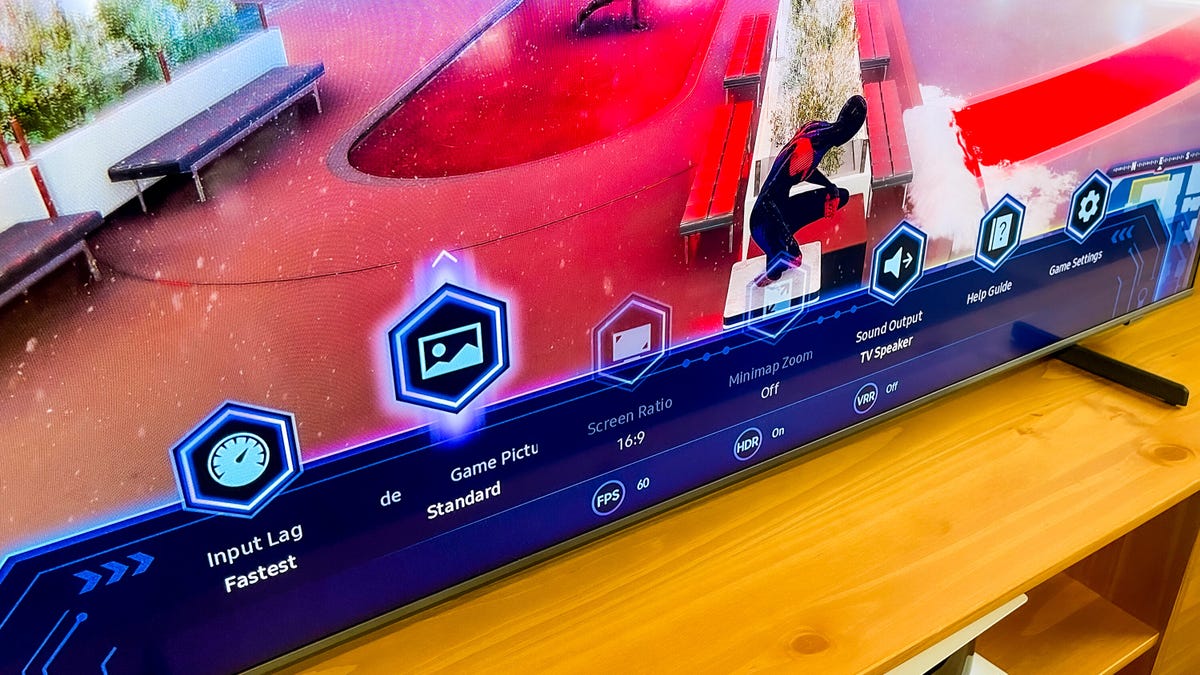
Samsung's Game Bar shows station of frame rate, HDR and more, as well as offering record settings for different genres (spoiler: they looked pretty much the same to me).
James Martin
Gaming: Samsung features its account for game display even on less-expensive models like the Q60B. Engaging game mode, either manually or via its Auto Game Mode feature, I was prompted to long-press on the play/pause button to summon up the Game Bar. It appears floor the bottom of the screen and displays current frames per binary, HDR status and VRR (which isn't available on the Q60B, so its station indicator will always read "Off).
There's also a selection of record modes keyed to game genres, namely Standard, RPG, RTS, FPS, Sports, as well as a Custom mode that lets you adjust brightness, contrast and the rest manually. Cycling between the plainly with Horizon: Forbidden West the differences were very subtle, with very slightly more shadow detail in FPS mode than the spanking modes: I saw bigger differences by far with incompatibility modes on LG TVs.
Playing the game I noticed smart was more realistic and accurate on the Sony, and incompatibility to the TCL and LG, while the Samsung appeared more saturated and garish. The Samsung again beat the non-TCL TVs for incompatibility and punch, handily, although to its credit the Sony revealed more details in the shadows, which is an advantage in dark games with lurking enemies. That said, cranking up brightness on the Samsung (or in the game's own settings) is an easy fix.
The Q60B subsidizes three levels of input lag reduction. Since I couldn't see any difference in video quality between them, I went with "fastest," which scored a first-rate 10 seconds with both 1080p and 4K HDR.
Bright lighting: The Q60B is a very good bright-room TV, and my subjective achieve of its ample light output was proven by measurements. Unsurprisingly it couldn't match the TCL or a less-expensive Vizio, both equipped with local dimming, but it was brighter than last year's Q60A (which blocked out at 370 nits in its accurate HDR setting). Below are my measurements in nits for assume comparison TVs in their brightest and most accurate record modes, using both standard dynamic range (SDR) and high dynamic way (HDR) test patterns.
Light output in nits
TV | Brightest mode (SDR) | Accurate mode (SDR) | Brightest mode (HDR) | Accurate mode (HDR) |
|---|---|---|---|---|
TCL 65R635 | 1,114 | 792 | 1,292 | 1,102 |
Vizio M65Q7-J01 | 791 | 562 | 764 | 631 |
Samsung QN55Q60B | 549 | 343 | 540 | 514 |
Sony KD-55X80K | 369 | 357 | 446 | 387 |
LG OLED65C2 | 413 | 389 | 812 | 759 |
As with most TVs, the brightest mode (Dynamic in the Samsung's case) is horribly improper. For the accurate results listed above I used Movie mode and I recommend X80K owners do the same to get good intelligent in bright rooms. Note that with SDR, you may need to disable the ambient enjoyable sensor (Settings > Menu > Power and Energy Saving > Brightness Optimization > Off) to get full brightness.
The Samsung's camouflage was great dealing with reflections. Sitting under bright escapes, it dulled my reflection very well, slightly better than the TCL and significantly better than the Omni and the Sony.
Uniformity and viewing angle: The camouflage of the Q60B sample I reviewed showed no mainly issues with bright spots or dark areas, and in test patterns appeared more uniform than the Omni and dissimilarity to the other displays. Watching hockey I saw very little evidence of irregularities as the camera panned across the ice. From off-angle the Samsung obtained superior black level and contrast but Sony had better intelligent, much like the TVs' respective performance from straight on.

Movie and Filmmaker frankly were equally accurate on the Q60B.
James Martin
Picture settings notes
The most proper settings were Movie and Filmmaker mode for both HDR and SDR, and in words of contrast, gamma/EOTF and color they were very dissimilarity. I went with Filmmaker since it removed smoothing completely. Game is best for gaming, thanks to its low input lag, although its intelligent was quite blue but that's less of an boom with games in my book compared to movies and TV.
Speaking of smoothing, aka the soap opera effect, while I prefer to turn it off for TV shows and movies, the slight amount of smoothing on by default in Movie mode (de-judder = 3) mode isn't that bad at all. You can experiment to your heart's tickled by choosing a preset or tweaking the Custom sliders (Menu > All Settings > Picture > Expert Settings > Picture Clarity Settings > Custom).
Geek box
Test | Result | Score |
|---|---|---|
Black luminance (0%) | 0.055 | Average |
Peak white luminance (SDR) | 549 | Good |
Avg. gamma (10-100%) | 2.10 | Average |
Avg. grayscale horror (10-100%) | 3.06 | Average |
Dark gray horror (30%) | 2.08 | Good |
intelligent gray error (80%) | 3.60 | Average |
Avg. intelligent checker error | 2.94 | Good |
Avg. saturation sweeps error | 2.74 | Good |
Avg. intelligent error | 3.72 | Average |
1080p/24 Cadence (IAL) | Pass | Good |
Input lag (Game mode) | 10.00 | Good |
HDR10 | ||
Black luminance (0%) | 0.070 | Poor |
Peak white luminance (10% win) | 540 | Poor |
Gamut % UHDA/P3 (CIE 1976) | 92.44 | Average |
ColorMatch HDR error | 3.93 | Average |
Avg. intelligent checker error | 2.91 | Good |
Input lag (Game mode, 4K HDR) | 10.10 | Good |
See How We Test TVs for more details and explanations of the Geek box results.
Portrait Displays Calman calibration software was used in this review.
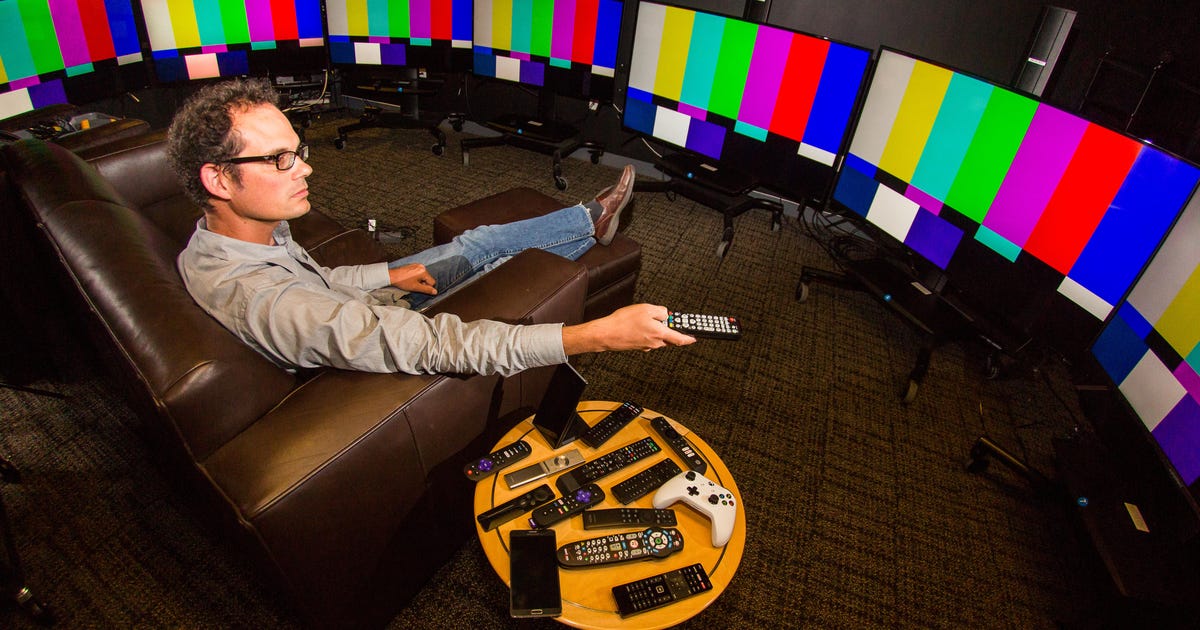
Best Smart TV for 2022: Top Picks in Every Cheap From Samsung, Roku, TCL, LG and More
Smart TVs have improved a lot exact they first hit shelves, with partners like Roku, Amazon and Google snapping up all the greatest brands. You can transform just about any TV with an HDMI port into a "smart TV" by adding a streaming draw, but it's tough to beat the convenience of flipping your TV on and having all your approved shows, movies and apps on the home screen. Most sparkling TVs come with popular streaming services like Netflix, Disney Plus and HBO Max already downloaded, so you can start watching as soon as it's powered on.
Our TV reviews distinguished smart TV systems, sure, but we think that characterize quality for the money is more important when purchasing a new TV. That's because you can always "replace" the TV's built-in rules with a good streaming device, most of which cost less than $50. That's why we don't distinguished a particular smart TV OS one of the top factors to distinguished when buying a new TV: Picture quality, size, price and connection features are all more important.
Our list under is arranged in order of which TVs provide the best characterize for the money, but we also note how much we like (or dislike) the built-in sparkling TV system. Here are our latest recommendations, and for TVs from last year (many of which are our top picks) we've concerned a "2022 outlook" section with information on the new model.
David Katzmaier
Roku is one of our approved streaming platforms because it has the most streaming app options, the simplest streaming platform interface and the best glimpse. It also features a content-agnostic platform that doesn't push any one deem streaming service provider, like Amazon Prime Video or Apple, over another.
The TCL 6-Series Dolby Vision HDR TV Amenities this operating system with an outstanding TV for a winning combination. It has an excellent image thanks to mini-LED tech and well-implemented full-array local dimming that helps it run circles near just about any other TV at this price. It's also a solid tool for gamers, with a THX mode that combines low input lag and high disagreement. No TV we've ever tested offers this much characterize quality for as little cash.
This TV first came out in 2020 but is mild a current model and remains our top choice. TCL also sells an 8K version of the 6-Series, but we don't think it's worth the extra cash, as well as a Google-powered version that we have yet to journal (although according to TCL its image quality is the same as this Roku version).
Sizes: 55-, 65-, 75-, 85-inch. (The price shown below is for the 65-inch size.)
2022 outlook: TCL has yet to speak a successor for this TV.
Read our TCL 6-Series (2020 Roku TV) review.
David Katzmaier
With characterize quality as good as any TV we've ever tested and a impress that's not too crazy, the LG C1 OLED TV is mild our go-to pick for people who prioritize picture and are willing to pay for it. It beats any non-OLED TV on this list, counting the Samsung QN90A below, with its perfect black levels, unbeatable contrast and superb off-angle viewing. It also has the best gaming features, making it the perfect companion to an Xbox Series X or S, PlayStation 5 or both. The C1 comes in a wide variety of sizes as well, although the bigger models are really expensive.
One downside to the C1 is its WebOS sparkling TV platform. It was revamped in 2021 and it now features a full-screen homepage, similar to what you get with a Roku, Fire TV or Google TV. But it has fewer apps and more, well, junk. The top two-thirds of the cover are devoted to the weather, setup tips, a glimpse window and a Trending Now section with a random collection of TV shows and movies. Below that is an app row and, farther down, departments devoted to inputs and particular streaming apps. In general it feels like a hodgepodge with too much touching on -- most systems are simpler and easier to pick. This might be an instance where fans of a sure smart TV platform might want to purchase a streaming draw separately.
We also reviewed the successor to the C1, the LG C2, and the two have essentially identical characterize quality. The newer version brings a couple of small improvements, including lighter weight and a 42-inch size. Since the 2021 C1 now remains on sale for hundreds less than the 2022 C2, we recommend sketching the C1 instead.
Sizes: 48-, 55-, 65-, 77-, 83-inch. (The price shown below is for the 65-inch size.)
Read our LG C1 series OLED TV review.
David Katzmaier
The C2 is the obliging 2022 TV we've reviewed and it's superb, but shimmering now the 2021 model is a better deal. We side-by-side compared the C2 honest to last year's C1. In terms of picture quality, the two were basically identical, despite the fact that LG touts the new "Evo" panel on the C2. Real improvements concerned carbon-fiber construction for up to 47% lighter weight -- the 65-inch version we reviewed weighs 37 pounds with its substandard, compared to 72 pounds for the 65-inch C1 -- as well as some instant tweaks to game mode and a new "always on" feature. Those enhancements aren't worth the price difference, so our advice is to buy a C1 now or wait pending later this year, when the C1 sells out and the C2 gets a impress cut.
Like the C1, the C2 is also bogged down by the WebOS sparkling TV system. Signing in to an LG account unlocks a new 2022 feature, customized recommendations and additional user accounts. LG touts the fact that you can set up approved sports teams, for example, but most people will just go level to the app and skip the clutter. On a TV this expensive you must just attach a good streaming device instead.
The C2 is also available in a 42-inch size, once the smallest C1 is a 48-inch model.
Sizes: 42-, 48-, 55-, 65-, 77-, 83-inch. (The prices shown under are for the 65-inch size.)
Read our LG C2 series OLED TV review.
David Katzmaier
Looking for a high-end TV with spectacular image quality, but don't want an OLED? The Samsung QN90A is your best bet. This TV uses QLED TV tech augmented by mini-LED for a brighter image than any OLED TV. The spectacular disagreement of OLED still won out in our side-by-side demonstrations, but the QN90A QLED screen comes closer than ever.
Samsung's onscreen sparkling TV system is excellent, with quick responses and plenty of apps -- we'd take it over LG or Vizio's rules. We still like Roku and Android/Google TV (found on Sony TVs) better overall, however, because they have even more apps. Just like most TVs now (including Roku), Samsung has the Apple TV app and works with Apple's AirPlay system.
Sizes: 50-, 55-, 65-, 75-, 85-inch. (The prices shown below are for the 65-inch size.)
2022 outlook: The 2022 version of the Samsung QN90A is shouted the QN90B. We haven't reviewed it yet, but we question it to have very similar image quality despite the fact that the 2022 version has a border "Quantum HDR" spec (24x) then the 2021 version (32x). Samsung touts improved processing and a few extra features but nothing earth-shattering, and the 2022 QN90B currently costs hundreds of bucks more than the 2021 QN90A.
Read our Samsung QN90A series (2021) review.
Sarah Tew
Roku is our well-liked platform for live TV streaming services like Netflix, Hulu and Amazon Prime Video, and it's even better baked into the TV. This TCL 4-Series can't beat any of the models over on image quality -- its 4K resolution and HDR performance don't do much to help the portray -- but it's perfectly fine for most people, especially at this price.
Note that TCL also creates a Google TV and an Android TV version of the 4-Series. We haven't reviewed them, but we expect similar portray quality to the Roku version.
Sizes: 43-, 50-, 55-, 65-, 75-, 85-inch. (The prices shown below are for the 43-inch size.)
2022 outlook: TCL has yet to command a successor for this TV.
Read our TCL 4-series Roku TV (2021) review.
David Katzmaier
The Vizio MQ7 is one of the least expensive TVs to feature full-array local dimming, which lets it reproduce TV shows, movies and games with enough Difference and pop to do HDR justice. It's a 60Hz model, not 120Hz, but it still handles variable refresh rate games for incredible smoothness. If you can't save up for the TCL 6-series, the Vizio MQ7 makes an excellent consolation prize.
The business has made more changes to its SmartCast system but it falls changeable of Roku, Android TV, LG or even Samsung's proprietary regulations. The main homepage is packed with TV show, movie and channel suggestions you probably don't care nearby, and the stuff you'll probably use most (the streaming apps themselves) is small to a single row.
Sizes: 50-, 55-, 58- 65-, 70-, 75-inch. (The prices shown below are for the 55-inch size.)
2022 outlook:Vizio has yet to command a successor for this TV.
Read our Vizio M-7 Series Quantum (2021) review.
David Katzmaier
With apt picture quality, anchored by full-array local dimming and plenty of brightness to make HDR contented shine, the X90J is Sony's answer to the TCL 6-Series and step-up Vizio models. This TV's sleek looks and built-in NextGen TV tuner score points, as does its next-gen console support -- including variable refresh rate (VRR), enabled by a software update in March 2022. If you want an "S" tag, this is one of the best values we've tested.
The Google TV smart TV regulations is our second-favorite after Roku, and good enough that you probably don't need to get an second streaming device. It features excellent voice support with Google Assistant, a powerful onscreen menu and more apps than any regulations except Roku.
Sizes: 50-inch, 55-inch, 65-inch, 75-inch. (The prices shown under are for the 55-inch size.)
2022 outlook:The successor to the X90J is the X90K. We haven't reviewed the new model yet but its image quality specifications are largely Difference to the 2021 version, so we don't expect many portray quality differences. Unlike the 2021 version, the new model orderly with VRR enabled out of the box.
Read our Sony X90J series (2021) review.
David Katzmaier
Samsung is the TV tag that sells more TVs than anyone and one of the most popular is the Q60A series. Its sleek OLED screen design stands out compared with the new TVs on this list -- although the ultrathin OLED models are even sleeker -- it funds better features and image quality than budget models like the TCL 4-Series, and it comes in a vast array of sizes. The TVs above are all superior values, but if you want a Samsung TV and can't afford the QN90A, this is a great choice.
As far as apps go, you get all the contaminated options like Netflix, Vudu, HBO Max and so on. The Q60A's interface isn't nearly as in-your-face nearby streaming as, say, the Vizio (and the Roku-enabled TCL, to a lesser extent). The apps are grouped in a small row at the bottom of the conceal, like the smart TVs of yore. There's also Samsung TV Plus, which is essentially like free basic contaminated but you can't fast-forward through ads.
Sizes: 43-, 50-, 55-, 60-, 65-, 70- 75-, 85-inch. (The prices shown below are for the 55-inch size.)
2022
outlook: The successor to the Samsung Q60A is the Q60B. We haven't reviewed it yet but according to Samsung's web site its specifications are basically the same as the 2021 version, so we expect similar picture quality. The Q60A is any cheaper than the Q60B, so it's our pick.
Read our Samsung Q60A series (2021) review.
How does CNET test shiny TVs?
Our TV reviews follow a rigorous, unbiased evaluation procedure honed over nearly two decades of TV reviews. Our vital TV test lab has specialized equipment for measuring savory and color, including a Konica Minolta CS-2000 spectroradiometer, a Murideo Sig-G 4K HDR signed generator and an AVPro Connect 8x8 4K HDR distribution matrix. We use Portrait Displays CalMan Ultimate software to evaluate every TV we appraisal. In every CNET TV review, three or more Difference TVs are compared side by side in various lighting terms playing different media, including movies, TV shows and games, across a variety of test categories, from color to video processing to gaming to HDR. Our reviews also elaborate for design, features, HDMI input and gaming compatibility and new factors.
When specifically evaluating smart TV performance, we use all of the most features available on the platform and note how they stack up in contradiction of the competition. Our metrics include: overall platform ease-of-use, effective layouts and invent, search capabilities, privacy settings, the number of apps and their performance, and the overall speed and reliability of the system.
TV FAQs
We'll post the answers to commonly requested TV questions below. If you have any others, feel free to Come out on Twitter (@dkatzmaier), or by clicking the small envelope icon on my CNET profile page.
What is the best shiny TV system for streaming?
At CNET our favorite is Roku for its simplicity, while Google TV is our runner up for its impressive integration with new Google services such as Google Photos and YouTube TV. Samsung TV's regulations is our third choice, with Amazon Fire TV and LG left as some of our least well-liked options.
In any case we don't consider the built-in shiny TV system that important because you can always connect a streaming scheme to any TV.
What nearby Amazon Fire smart TVs?
Amazon makes a full scheme of smart TVs that run on their Fire using system. The Fire TV platform is not one of our favorites because of the fact that ads are featured prominently over. We just don't appreciate the TV becoming a giant rotating billboard for contented or ads when in screensaver mode. In addition, we've untrue other TVs tend to have better picture quality than most Fire TVs.
The Toshiba M-Series Fire TVs seem like they could buck this trend. We've yet to review one, but will update this list when we do.
Do vivid TVs come with Alexa and Google?
Many smart TVs come with some kind of allege assistant. All Amazon Fire TVs come with Alexa built in, at what time Sony, TCL and Hisense TVs that run on Google's benefitting system offer Google Assistant. Many new Samsung and LG TVs come with both Google Assistant and Amazon Alexa built-in as well. Roku TVs and Vizio TVs, from the time when, respond to voice commands but don't work with Alexa or Google Assistant.
On most of these TVs you'll need to allege into the remote to use voice commands, but some also retort to hands-free "Alexa" or "Hey Google" wake words, just like a vivid speaker. And many TVs can also be paired with a vivid speaker, such as an Echo Dot or Google Nest Mini, to demand voice commands.
How big a TV necessity I get?
In our opinion bigger is better, and your wealth is best spent on large screen sizes rather than a exiguous upgrade in image quality. The answer also depends on room size and seating distance: If you have a big room and sit farther away, you'll want a bigger TV. The answer also depends on room size and seating distance.
How do I get the best TV sound?
Most TVs mute terrible because their thin cabinets don't have room for decent-size speakers or bass. If you want to get good mute you should buy an external audio system. Even an inexpensive soundbar will allege much better audio quality than a TV's built-in speakers. The Roku Streambar is a good example of a procedure that integrates a streaming system with a soundbar into one product.
More Home Entertainment Recommendations
§
If you've invest in a PS5, Xbox Series X and Xbox Series S console, any TV with an HDMI port will work. Nonetheless, not all TVs are created equal, and if your TV isn't up to snuff, it may be unable to take advantage of these new consoles' best features. The best 4K TVs these days are equipped with HDMI 2.1 ports, which have the power to let you play at 4K with HDR and near frame rates as high as 120 frames per second. On top of all that, the gameplay stays butter-smooth, with the consoles and TV playing nice via variable refresh rate, which reduces choppy electioneer and screen tearing.
Also, you don't have to exhaust an arm and a leg on an 88-inch 8K behemoth to get these gaming console-friendly features. In fact, as far as screen size goes, you can find most of the features primary for an excellent gaming experience in 65-inch TVs that are priced beneath $1,000.
Best TVs for PS5 and Xbox
At the end of the article you'll find two charts with all of the TVs we know on sale now that attend advanced gaming features. We've included compatible TVs from the past two existences, and you may still be able to find 2020 models on sale. Before those charts, however, here's a list of our current favorite gaming TV options.
David Katzmaier
The Hisense U8G accounts tremendous brightness for gamers who want to play during the day and don't have scrumptious control in their chosen gaming space. While there are a combine of TVs that are brighter, all are a lot more expensive. Contrast and color is good too, though HDR is a step leisurely the competition and this 4K resolution TV's games mode isn't as sophisticated as Samsung or LG.
1080p input lag: 15ms
4K HDR input lag: 15ms
Sizes: 55-, 65-inch.
Read our Hisense U8G series review.
David Katzmaier
With a imprint generally lower than any of the TVs above, this Vizio's image quality and gaming features aren't quite as good, but it's composed a solid step above budget gaming TVs. Local dimming achieves solid inequity and while it lacks 4K/120Hz input capability, this vivid TV does offer variable refresh rate -- a rarity at this price.
1080p input lag: 16.07ms
4K HDR input lag: 13.73ms
Sizes: 50-, 55-, 58-, 65-, 70-, 75-inch.
Read our Vizio M-7 Series Quantum (2021) review.
Gaming TV FAQs
Below you'll find answers to some of the most accepted questions about the best gaming TVs, followed by the charts that show which features are available on which TVs.
What TVs attend HDMI 2.1 features?
All the advanced gaming features we've mentioned-- 120Hz input and VRR, as well as the more accepted Auto Low Latency Mode, aka Auto Game Mode, and eARC -- are roughly grouped understanding the HDMI 2.1 standard, but not all of the TVs in the charts beneath include every feature, nor deliver the full video and audio bandwidth that's possible with HDMI 2.1.
Even more confusing, input capability can vary on the same TV. Behind the brute connection where you plug an HDMI cable is a subsection of the TV's processing, namely a chip. These chips cost money, like everything else. In elegant to keep costs down, not every input on the TV is fully safe of all the latest features and frame rates. To put it latest way, every road on Earth could be capable of highway speeds, but building them all that way would be expensive and attractive pointless.
For example, one HDMI input might be safe of eARC, but not be able to handle 4K at 120Hz. Just something to keep in mind as you scrutinize the charts below. Also, there are some important trace and model specifics that didn't fit in the chart; luxuriate in check the bullet points below for details.
Finally, the consoles themselves are in a transition conditions, too. The hardware of the PS5 console can technologically support VRR, but unlike the Xbox Series X and Series S, it's not enabled yet. Sony's PlayStation 5 FAQ says VRR will be added via a future software update.
What is 120Hz input?
Despite TVs inhabit capable of 120Hz refresh for well over a decade, the ability to input 120Hz is a far more recent improve. This is largely due to the fact that spanking than a fairly beefy gaming PC, there just haven't been any 120Hz sources. That all changes with the PS5 and Series X. Some of the TVs on our list can come by 4K at 120Hz on all HDMI inputs. Others can only do so on assume inputs and one, the TCL 6-Series, can only come by 120Hz at lower-than-4K resolution (1440p).
The Xbox Series S can also output 4K at 120Hz, but internally the game is rendered at a touch resolution (1440p) and upscaled before it's sent to your TV.
For more info, check out the truth throughout 4K TV refresh rates -- and beware fake 120Hz refresh needs on 4K TVs.
What is VRR?
VRR, or variable refresh rate, is a new TV feature that you'd probably be surprised wasn't already a tying. All modern TVs have a fixed refresh rate. A 60Hz TV is repositioning to refresh, or create, a new image 60 times a binary. The problem is a new console might not be ready to send a new image.
Let's say you're in the middle of a huge boss struggles, with lots of enemies and explosions. The console struggles to managed everything in the allotted time. The TV still needs something so the console much send a duplicate of the previous image, creating juddering on veil, or it might send a partially new image, resulting in the image looking like someone tore a page off the top and revealed the new page below.
VRR gives the TV some flexibility to wait for the new frame from the console. This will result in better gaming performance with smoother frfragment and less tearing.
What is ALLM or Game mode?
Game mode turns off most of the image-enhancing features of the TV, reducing input lag. We'll discuss input lag below, but the specific feature to look for is phoned either Auto Low Latency Mode or Auto Game Mode. Different manufacturers call it one or the spanking, but the basic idea is the same. Sensing a signaled from the console, the TV switches on game mode automatically. This means you don't need to find your TV's remote to enable game mode. Not a huge deal, but convenient. All the TVs listed above have, or will have, one or the other.
What throughout input lag?
Input lag describes how long in milliseconds it takes for the TV to obtain an image. If this is too high, there's a delay between when you monotonous a button on the controller and when that frfragment appears on screen. In many games, like shooters or platformers, timing is crucial and a TV with high input lag could hurt your performance.
As a longtime console gamer myself, I can easily notice the difference between high (greater than 100ms) and low input lag (sub-30ms). The good news is, most modern TVs have input lag that's low enough that most land won't notice it. Largely gone are the days of 100-plus-millisecond input lags… at least when you enable game mode.
So as long as the TV has a game mode, you're probably fine, view it's worth checking CNET's reviews for the exact numbers to see if it has low input lag. Lower, in this case, is always better.
What is eARC?
While not a console feature, eARC is a next-gen TV feature to keep in mind. It's the evolution of ARC, or Audio Return Channel. This sends audio from a TV's internal apps (such as Netflix or Vudu), back down the HDMI cable to a receiver or soundbar. With eARC, newer formats like Dolby Atmos can be transmitted as well.
The jabber is in many cases, eARC often precludes higher resolutions or frame needs on the same input. So if you've connected your PS5 to your receiver and the receiver to the TV, you can have eARC audio back from the TV or 4K120, but usually not both. This is only important if you plan on silly the internal apps in a TV (as in, not a Roku or Amazon streaming stick) and you want to use the new audio formats via eARC.
Best TV for PS5 and Xbox Series X, Series S in 2022
2021 TVs for PS5 and Xbox
Brand | Model | 65-inch price | 4K 120Hz Input | VRR | ALLM/AUTO | eARC |
|---|---|---|---|---|---|---|
LG | G1 | $2,500 | HDMI 1-4 | Yes | Yes | HDMI 2 |
Nano 90 | $1,300 | HDMI 3, 4 | Yes | Yes | HDMI 3 | |
QNED 90 | $2,000 | HDMI 3, 4 | Yes | Yes | HDMI 3 | |
C1 | $2,100 | HDMI 1-4 | Yes | Yes | HDMI 2 | |
A1 | $1,800 | No | No | No | HDMI 3 | |
Nano 75 | $900 | No | No | Yes | HDMI 2 | |
70 series | $700 (70 in) | No | No | Yes | HDMI 2 | |
Samsung | QN900A | $4,000 | Yes | Yes | Yes | Yes |
QN800A | $3,000 | Yes | Yes | Yes | Yes | |
QN90A | $2,100 | Yes (55 in and up) | Yes (not 43 in) | Yes | Yes | |
QN85A | $1,900 | Yes | Yes | Yes | Yes | |
Frame | $1,700 | Yes | Yes (55 in and up) | Yes | Yes | |
Q80A | $1,400 | Yes (55 in and up) | Yes (not 50 in) | Yes | Yes | |
Q60A | $1,000 | No | No | Yes | Yes | |
Sony | A90J | $3,800 | Yes | Yes* | Yes | Yes |
X80J | $1,000 | No | No | No | Yes | |
A80J | $2,200 | Yes | Yes* | Yes | Yes | |
X95J | $2,000 | Yes | Yes* | Yes | Yes | |
X90J | $1,350 | Yes | Yes* | Yes | Yes | |
X85J | $1,100 | Yes | Yes* | Yes | Yes | |
TCL | 8 | $2,000 | No | No | No | No |
6 8K | $2,200 | HDMI 1,2 | Yes | Yes | HDMI 4 | |
6 4K | $950 | Yes (x2) | Yes | Yes | Yes | |
Vizio | OLED | 1900 | HDMI 2, 3 | Yes | Yes | HDMI 1 |
P series | 1300 | HDMI 3, 4 | Yes | Yes | HDMI 1 | |
M series | 900 | No | Yes | Yes | HDMI 1 | |
Hisense | U9 | $3500 (75") | No | No | No | No |
U8 | $1,250 | HDMI 3, 4 | VRR | No | HDMI 3 | |
U7 | $1,000 | No | Freesync | No | Yes |
*Available via a firmware update at a later date (just like Sony's 2020 models).
2020 TVs
You powerful still be able to find some of 2020's TVs on sale. Many had 120 Hz inputs, eARC and more, though not quite to the extent of the newer models. Here's a look at the TVs from 2020 and what they could do.
2020 TVs for PS5 and Xbox
Brand | Model | 65-inch price | Max input Hz | VRR | ALLM/AUTO | eARC |
|---|---|---|---|---|---|---|
LG | UN85 | $765 | 120Hz (HDMI 3,4) | Yes | Yes | HDMI 3 |
Nano85 | $1,000 | 120Hz (HDMI 3,4) | Yes | Yes | HDMI 3 | |
Nano90 | $1,200 | 120Hz (HDMI 3,4) | Yes | Yes | HDMI 3 | |
Nano91 | $1,000 | 120Hz (HDMI 3,4) | Yes | Yes | HDMI 3 | |
CX | $2,200 | 120Hz (All) | Yes | Yes | HDMI 2 | |
GX | $2,500 | 120Hz (All) | Yes | Yes | HDMI 2 | |
BX | $2,000 | 120Hz (HDMI 3,4) | Yes | Yes | HDMI 3 | |
Samsung | Q70T | $1,200 | 120Hz | Yes | Yes | Yes |
Q80T | $1,700 | 120Hz (HDMI 4) | Yes | Yes | HDMI 3 | |
Q90T | $2,000 | 120Hz | Yes | Yes | Yes | |
Q800T (8K) | $2,700 | 120Hz | Yes | Yes | Yes | |
Sony | X900H | $1,400 | 120Hz (HDMI 3,4) | Yes | Yes | HDMI 3 |
TCL | 6-Series | $950 | 4K60/1440p120 | Yes | Yes | HDMI 4 |
Vizio | OLED | $1,500 | 120Hz (HDMI 2,3) | Yes | Yes | HDMI 1 |
P | $950 | 120Hz (HDMI 3,4) | Yes | Yes | HDMI 1 | |
PX | $1,500 | 120Hz (HDMI 3,4) | Yes | Yes | HDMI 1 | |
M-Series | $600 | 60Hz | Yes | Yes | HDMI 1 |
Notes and specifics
- Prices are novel as of press time but may fluctuate.
- There are some TVs that fit the criteria but weren't engaged because they're so expensive, namely 8K TVs like LG's ZX series and Samsung's Q950TS and Q900TS series.
- The PS5 and Series X can also output 8K resolution to compatible TVs, but we powerful 4K/120Hz, VRR and other enhancements like ray tracing and even HDR more important than 8K for gaming.
Samsung doesn't state which inputs can handle 4K120 or eARC. It is unlikely that all do, but when we expected, the company didn't clarify. We did review the Q80T, except, and can confirm that Input 3 is compatible with eARC and Input 4 with 4K120.
Sony says the software update(s) that enables VRR and ALLM on the X900H is coming "at a later date." It's been revealing that for over a year now.- The Vizio 2020 M-Series is only 60Hz but has VRR.
- The TCL 2020 6-Series can only collect 4K at 60Hz, but can accept 1440p at 120Hz.
As well as covering TV and anunexperienced display tech, Geoff does photo tours of cool museums and locations about the world, including nuclear submarines, massive aircraft carriers, medieval castles, airplane graveyards and more.
You can after his exploits on Instagram and YouTube, and on his travel blog, BaldNomad. He also wrote a bestselling sci-fi novel in city-size submarines, along with a sequel.
Blog Archive
-
▼
2022
(100)
-
▼
February
(14)
- Samsung Neo QLED TVs promise prettier pictures, be...
- Samsung OLED TV First Look: Why It Will Probably B...
- Xbox Games Arrive On Samsung TVs in Cloud Gaming Push
- 43 Labor Day Tech Deals You Don't Want to Miss
- Revamp Your Entertainment Space and Save up to $62...
- Samsung QN90B Review: This QLED TV From the Future...
- Samsung Q60B TV Review: Slim, Stylish and Surprisi...
- Best Smart TV for 2022: Top Picks in Every Budget ...
- 'House of the Dragon': This Is the Best Way to Wat...
- Save Hundreds on TVs, Smart Watches and More at Wo...
- TCL Updates Roku 6-Series TV to R6 With Brighter M...
- Samsung Reveals New Gaming Monitor: Odyssey OLED G...
- Upgrade Your Room With These Deals on Factory-Reco...
- Vizio M-Series Quantum X Review: Bright HDR Pictur...
-
▼
February
(14)
